Fall 2016
Editor’s Note
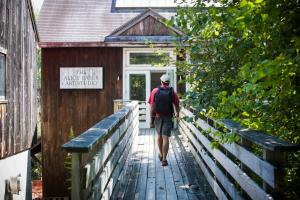 “Ultimately, Marlboro’s small size is a strength,” says alumnus Aaron Kisicki, an attorney for the state of Vermont profiled in this issue of Potash Hill (page 46). “If you want to experience a community that is like-minded, in terms of significant intellectual engagement with ideas of personal interest, you’re always going to end up with smaller numbers.” Not only is small beautiful, it is a function of Marlboro’s core mission to teach students to think independently and be part of a learning community.
“Ultimately, Marlboro’s small size is a strength,” says alumnus Aaron Kisicki, an attorney for the state of Vermont profiled in this issue of Potash Hill (page 46). “If you want to experience a community that is like-minded, in terms of significant intellectual engagement with ideas of personal interest, you’re always going to end up with smaller numbers.” Not only is small beautiful, it is a function of Marlboro’s core mission to teach students to think independently and be part of a learning community.
Marlboro’s small wonder is highlighted in the first of many editorials from President Kevin, titled “Tiny Colleges Matter,” and in the instructive slice of fundraising history from former Marlboro development chief Will Wootton’s upcoming memoir. It shines through in the U.S. News & World Report #1 ranking of lowest student-faculty ratio, and in Jean O’Hara and Jodi Clark’s pioneering course in community. This issue of Potash Hill is jam-packed with smallness.
We start off with a vivid example of Marlboro’s strength in smallness, of students “engaging in what they are doing in a significant way.” Sasha Iammarino’s photo essay on migrants from Brazil illustrates that no place is an island, not even an island like Martha’s Vineyard. There has been a lot of talk about immigration in the past year, but Sasha’s nuanced research brings the individual stories behind transnationalism into focus in a way that no political campaign can.
Speaking of small, did I mention that your very own alumni magazine has once again won an excellence award from the Council for Advancement and Support of Education (CASE)? Potash Hill won bronze in the CASE District 1 overall category for magazines with a circulation of 50,000 and under. With a circulation of only 5,000, this is yet another surprising example of Marlboro’s Mighty-Mouse-like powers. Learn more.
What do you think are Marlboro’s greatest strengths? What is your fondest memory of life in an intentionally small learning community? Share your thoughts, big and small, with us at pjohansson@marlboro.edu.
—Philip Johansson
Inside Front Cover
Potash Hill
Published twice every year, Potash Hill shares highlights of what Marlboro College community members, in both undergraduate and graduate programs, are doing, creating, and thinking. The publication is named after the hill in Marlboro, Vermont, where the undergraduate campus was founded in 1946. “Potash,” or potassium carbonate, was a locally important industry in the 18th and 19th centuries, obtained by leaching wood ash and evaporating the result in large iron pots. Students and faculty at Marlboro no longer make potash, but they are very industrious in their own way, as this publication amply demonstrates.
Chief External Relations Officer: Matthew Barone
Alumni Director: Kathy Waters
Editor: Philip Johansson
Photo Editor: Ella McIntosh
Staff Photographers: Ben Rybisky ’18 and Lindsay Stevens ’17
Design: New Ground Creative
Potash Hill welcomes letters to the editor. Mail them to: Editor, Potash Hill, Marlboro College, P.O. Box A, Marlboro, VT 05344, or send email to pjohansson@marlboro.edu. The editor reserves the right to edit for length letters that appear in Potash Hill.
Front Cover: A graffiti-adorned building in São Paulo, Brazil, gives conflicting signals of both progress and decline, security and vulnerability, optimism and despair. Similar conflicts are felt by migrants who divide their lives between Brazil and the U.S., as revealed in a recent graduate’s research on Brazilian migrants (page 8). Photo by Sasha Iammarino
“This is a place for you to learn you,” says Malachie Reilly ’17 (pictured right) in a recent video profile about pursuing his passion at Marlboro. For Malachie, this includes playing every sport available to him, which is surprisingly many for a college that consistently ranks in Princeton Review’s top 10 for “There’s a Game?” See Malachie.
About Marlboro College
Marlboro College provides independent thinkers with exceptional opportunities to broaden their intellectual horizons, benefit from a small and close-knit learning community, establish a strong foundation for personal and career fulfillment, and make a positive difference in the world. At our undergraduate campus in the town of Marlboro, Vermont, and our graduate center in Brattleboro, students engage in deep exploration of their interests—and discover new avenues for using their skills to improve their lives and benefit others—in an atmosphere that emphasizes critical and creative thinking, independence, an egalitarian spirit, and community.
Up Front
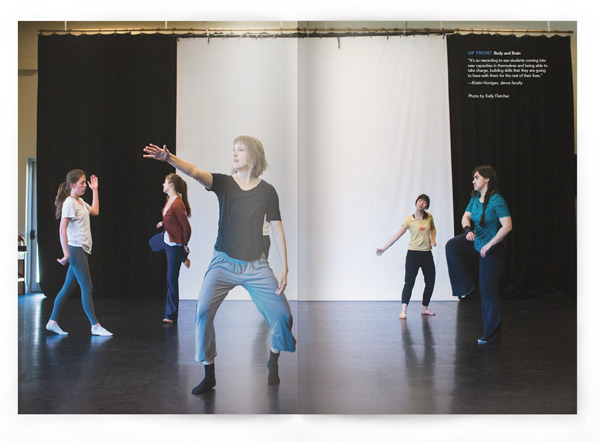
Body and Brain
“It’s so rewarding to see students coming into new capacities in themselves and being able to take charge, building skills that they are going to have with them for the rest of their lives.”
—Kristin Horrigan, dance faculty
Photo by Kelly Fletcher
Clear Writing
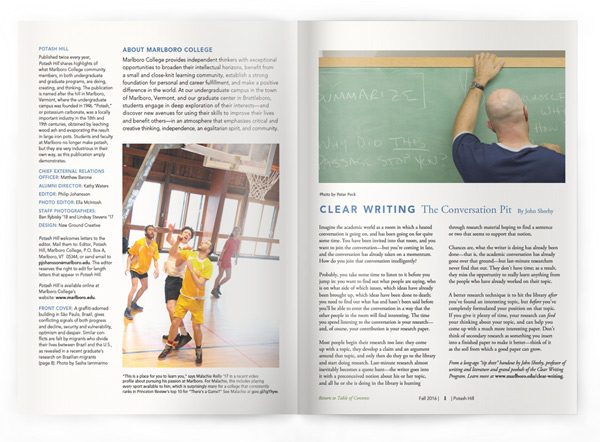
The Conversation Pit
By John Sheehy
Imagine the academic world as a room in which a heated conversation is going on, and has been going on for quite some time. You have been invited into that room, and you want to join the conversation—but you’re coming in late, and the conversation has already taken on a momentum. How do you join that conversation intelligently?
Probably, you take some time to listen to it before you jump in: you want to find out what people are saying, who is on what side of which issues, which ideas have already been brought up, which ideas have been done to death; you need to find out what has and hasn’t been said before you’ll be able to enter the conversation in a way that the other people in the room will find interesting. The time you spend listening to the conversation is your research—and, of course, your contribution is your research paper.
Most people begin their research too late: they come up with a topic, they develop a claim and an argument around that topic, and only then do they go to the library and start doing research. Last-minute research almost inevitably becomes a quote hunt—the writer goes into it with a preconceived notion about his or her topic, and all he or she is doing in the library is hunting through research material hoping to find a sentence or two that seems to support that notion.
Chances are, what the writer is doing has already been done—that is, the academic conversation has already gone over that ground—but last-minute researchers never find that out. They don’t have time; as a result, they miss the opportunity to really learn anything from the people who have already worked on their topic.
A better research technique is to hit the library after you’ve found an interesting topic, but before you’ve completely formulated your position on that topic. If you give it plenty of time, your research can feed your thinking about your topic, and can help you come up with a much more interesting paper. Don’t think of secondary research as something you insert into a finished paper to make it better—think of it as the soil from which a good paper can grow.
From a long-ago “tip sheet” handout by John Sheehy, professor of writing and literature and grand poobah of the Clear Writing Program. Learn more. Photo by Peter Peck
Letters

Pet Fetish
A tale of democracy in action from Tim Little ’65
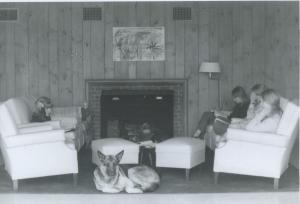 “When I was a student there was a rule against pets. And so someone—I know who it was but I won’t say his name—someone brought a pet on campus. It was a dog, a very nice dog, named for the very famous Argentine car racer Juan Manuel Fangio—so he was Fangio. The Town Meeting passed a resolution that made Fangio a person, and then excused him from paying tuition. And so he lived on the top floor of Mather.
“When I was a student there was a rule against pets. And so someone—I know who it was but I won’t say his name—someone brought a pet on campus. It was a dog, a very nice dog, named for the very famous Argentine car racer Juan Manuel Fangio—so he was Fangio. The Town Meeting passed a resolution that made Fangio a person, and then excused him from paying tuition. And so he lived on the top floor of Mather.
“The biggest thing Fangio was able to do was befriend Don Woodard, the man who did all the buildings and grounds, the only one who did all of that. Don was also the sheriff of Marlboro, and lived on campus. He was a very difficult man to get along with, although I never had any trouble with him at all. But he took to Fangio, and so that meant that Fangio could stay.”
No, the noble beast pictured (right) is not Fangio, but perhaps you know her name and degree field? Do you have a favorite pet story, pet peeve, or pet name from your days at Marlboro? If you have a Marlboro memory to share, or any other reflection from this issue of Potash Hill, send it to pjohansson@marlboro.edu.
Loving Potash
I read the magazine and was duly impressed!
—Deborah Beale ’69
Creative Thinkers
The letter from Geoffrey Hendricks about wanting “creative thinkers to make up the board beside the traditional lawyers and bankers” brings me to the inside back cover. Sitting with the young Tom Ragle is one of the “traditional bankers,” Henry Z. Persons, president of the Brattleboro Savings & Loan. My husband, Paul Olson, was one of the “traditional lawyers,” and he told me the following story from the 1950s.
Paul was sitting home one Sunday afternoon, minding his own business, when he spied Zee Persons and Arthur Whittemore trudging up the drive. They had come to ask him to be the trustee in bankruptcy for Marlboro College. His first reaction was to refuse, but they tossed it around for a while and he finally said he’d think it over. A day or two later he and Zee got together and indulged in some superbly “creative thinking” that resulted in the rescue of the college and their enduring friendship.
—Dorothy Olson, friend
Ultimate Memories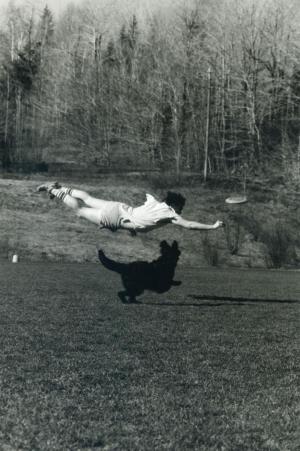 As I was flipping through the latest edition of Potash Hill I caught a glimpse of a photo and thought, “Oh, look, they printed the picture of Kip (Morgan ’86) making a diving Frisbee catch.” I think it’s also worth noting that Kip was (in)famous for his diving catches. Our Ultimate Frisbee “team” played a few other colleges: Hampshire, Williams, and Bennington come to mind. We called ourselves “The Marlboro Moo-Jah-Hadin,” back when we considered those fighting the invading Westerners (Russians at that time) in Afghanistan to be “freedom fighters” instead of “terrorists.” The “Moo” part is of course a reference to Vermont agriculture, and the “Jah” part is a reference to our, um, proclivities, the genetic source of which was also Afghanistan, and our method was guerilla agriculture. So it all worked together quite nicely. I do not remember the dog, however.
As I was flipping through the latest edition of Potash Hill I caught a glimpse of a photo and thought, “Oh, look, they printed the picture of Kip (Morgan ’86) making a diving Frisbee catch.” I think it’s also worth noting that Kip was (in)famous for his diving catches. Our Ultimate Frisbee “team” played a few other colleges: Hampshire, Williams, and Bennington come to mind. We called ourselves “The Marlboro Moo-Jah-Hadin,” back when we considered those fighting the invading Westerners (Russians at that time) in Afghanistan to be “freedom fighters” instead of “terrorists.” The “Moo” part is of course a reference to Vermont agriculture, and the “Jah” part is a reference to our, um, proclivities, the genetic source of which was also Afghanistan, and our method was guerilla agriculture. So it all worked together quite nicely. I do not remember the dog, however.
—Markus Brakhan ’86
I recognize the photo on page 7 of the Spring 2016 issue. That is Kip Morgan ’86. I don’t remember the dog.
—Anders Newcomer ’86
I can’t tell you who the dog is, but the guy in the Frisbee photo is Christopher “Kip” Morgan ’86.
—John Ruble ’86
That’s Kip Morgan ’86. We were so fired up on Ultimate Frisbee in those days . . . we would run through the dorms chanting “Ultimate!” and rally the games. We would occasionally play against Hampshire College, but mostly just had a great time. I don’t recall the dog’s name, although Kip landed clean!
—James Dickey ’88
And from a related facebook thread
Now that was a fun day—as were they all at Marlboro. Christina Faggi (’84) took the pic with Boo Stearns’ (’86) camera. Pretty sure it was Jim Dickey who threw it, and I was lucky enough to catch it. We used to practice layouts on the field. The pic made the back cover of Potash Hill that season. My 15 minutes . . .
—Kip Morgan ’86
We have it on good authority that the dog is Fang, who belonged to Douglas Noyes ’83, not to be confused with Fangio. —Eds.
Trustee Tribulations
This is written in the spirit of what Dick Judd used to call an “instructional” letter. I am seeing in many places these days the spurious claim that Robert Frost was Marlboro College’s first trustee. There is no truth to this statement. The college’s first trustee was
Arthur Whittemore, a fact that was once and should continue to be well understood at the college. Frost was, in actual fact, the first person formally asked to become a trustee, and we know that request was made on August 6, 1946, in Ripton. There is a big difference between being the first trustee and the first person asked to be a trustee. Arthur Whittemore, a summer resident of Marlboro who later became an esteemed Massachusetts Supreme Judicial Court Justice, had been laying the groundwork for the college through the early part of that summer with Walter Hendricks, and there had been an understanding from the beginning, perhaps as early as that spring and maybe before, that he would lead the board.
Although Frost’s influence had helped plant the seed for the idea of a college in Walter’s imagination, prior to Walter Hendricks’ visit to Frost’s cabin in Ripton on August 6, Frost had not heard of the soon-to-be Marlboro College. Hence, Frost may well have been the second trustee, but there is perhaps no way of knowing for sure. What we do know is that he never attended a trustees’ meeting, and it was clear from the beginning that Walter Hendricks never expected him to. Frost once signed a book to Walter “From your trusted but untrustworthy trustee,” a tacit and humorous acknowledgement that he was a trustee in name only.
If Frost had a formal (actually, quite informal) responsibility at the college he took seriously it was his role as a “Visiting Associate in Teaching.” There Frost made a real difference with Marlboro students and he did it, characteristically, on his own terms.
—Dan Toomey ’79
“Our Heart Divides in Two”: Bifocality in the Experience of Brazilian Migrants
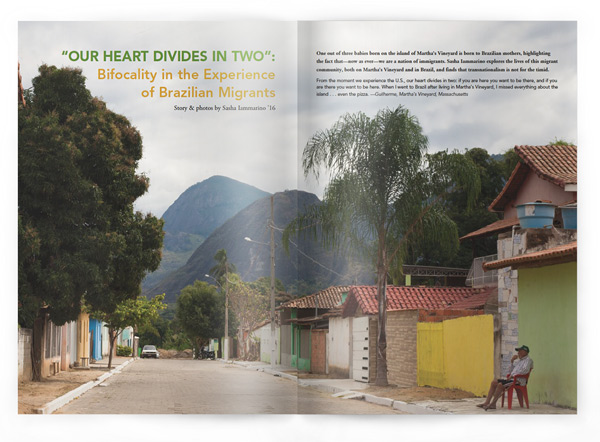
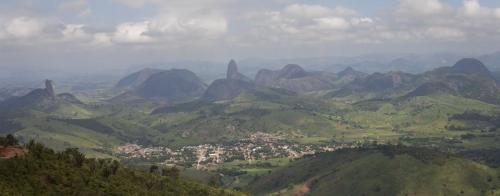 Story & photos by Sasha Iammarino ’16
Story & photos by Sasha Iammarino ’16
One out of three babies born on the island of Martha’s Vineyard is born to Brazilian mothers, highlighting the fact that—now as ever—we are a nation of immigrants. Sasha Iammarino explores the lives of this migrant community, both on Martha’s Vineyard and in Brazil, and finds that transnationalism is not for the timid.
"From the moment we experience the U.S., our heart divides in two: if you are here you want to be there, and if you are there you want to be here. When I went to Brazil after living in Martha’s Vineyard, I missed everything about the island . . . even the pizza."
—Guilherme, Martha’s Vineyard, Massachusetts
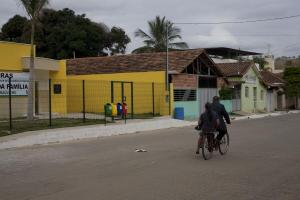 Beginning in the latter part of the 1980s, a small-scale migration emerged from within the Brazilian towns of Mantenópolis and Cuparaque, near the city of Governador Valadares, to one location in the United States: Martha’s Vineyard, Massachusetts. Although the influence of this migration is apparent in the large houses and businesses built by migrants in both Brazilian towns, there are few sources of information about how these migrants became incorporated into Martha’s Vineyard while remaining active in the towns they come from. The changed lives of these mantenopolitanos and cuparaquenses, as they are called, are embedded in the individual stories of the people who migrated, their families, and their friends.
Beginning in the latter part of the 1980s, a small-scale migration emerged from within the Brazilian towns of Mantenópolis and Cuparaque, near the city of Governador Valadares, to one location in the United States: Martha’s Vineyard, Massachusetts. Although the influence of this migration is apparent in the large houses and businesses built by migrants in both Brazilian towns, there are few sources of information about how these migrants became incorporated into Martha’s Vineyard while remaining active in the towns they come from. The changed lives of these mantenopolitanos and cuparaquenses, as they are called, are embedded in the individual stories of the people who migrated, their families, and their friends.
As part of my Plan of Concentration research, I conducted surveys and interviews with Brazilian migrants who live on Martha’s Vineyard, as well as those who have returned to Brazil after living on the island. I conducted all of the interviews in Portuguese and translated them into English myself. The voices of the people I interviewed best articulate the difficulty migrants face as they attempt to improve their lives and the ways they negotiate their experiences both in their place of origin and on Martha’s Vineyard.
 It is really difficult, because our family stays there [Mantenópolis]. His father is there, my mother, my two uncles, and other relatives. Our family weighs on our desire to return to Brazil… It is easier for my children to return to Brazil and then come back here. I want to send them there to visit Brazil.
It is really difficult, because our family stays there [Mantenópolis]. His father is there, my mother, my two uncles, and other relatives. Our family weighs on our desire to return to Brazil… It is easier for my children to return to Brazil and then come back here. I want to send them there to visit Brazil.
–Júlia, 26 years old, lives on Martha’s Vineyard
The majority of Brazilians that go to the island in the work season go thinking about how much they can save, so they return. We were not like that. We wanted a stable life there. But the money that we ended up saving up, after being there for a while, we started investing in Mantenópolis…. We were born here, we grew up here, we are familiar with here, so we came here. We returned to Mantenópolis.
–Marlene, 45 years old, lives in Mantenópolis
 It is a cultural story…. So many Americans that go to Brazil want to live there. So why can’t we do the same here? I know people from my town [Mantenópolis] that are married to Americans, have a family here [Martha’s Vineyard], have children, the husband already speaks Portuguese, or vice versa, the American wife learns Portuguese. So there is this mixture. This migration is renewing itself, the culture of the country… there is that thing going on here—how do you say it—the intermixing of culture.
It is a cultural story…. So many Americans that go to Brazil want to live there. So why can’t we do the same here? I know people from my town [Mantenópolis] that are married to Americans, have a family here [Martha’s Vineyard], have children, the husband already speaks Portuguese, or vice versa, the American wife learns Portuguese. So there is this mixture. This migration is renewing itself, the culture of the country… there is that thing going on here—how do you say it—the intermixing of culture.
–Guilherme, 36 years old, lives on Martha’s Vineyard
I wanted to go back to Brazil because of my family. I also worked too much, and it got to the point where I was too tired…. My experience there was good, but if we didn't have to work so much... There are a lot of people who say that Brazilians are made into slaves once they are in the U.S., but the reality is that we make ourselves into slaves when we are here. Because we want to return soon, and the more we work the faster we will return.
–Victória, 45 years old, lives in Cuparaque
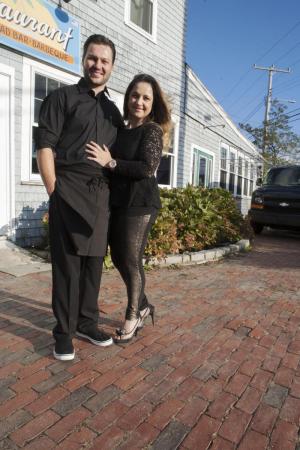 I don’t want to leave here; I really like it here. It is tranquil. The life of my children is good because I have peace here. I have the peace to sleep with my front door unlocked the whole night. Things are changing, but compared to other places this is paradise. In Mantenópolis it is much more difficult… because people still struggle there a lot in general. And unfortunately Mantenópolis is really violent, there is a lack of security, a lack of order, so it is still pretty bad there. I enjoy traveling there because our family is there. But I prefer to live here.
I don’t want to leave here; I really like it here. It is tranquil. The life of my children is good because I have peace here. I have the peace to sleep with my front door unlocked the whole night. Things are changing, but compared to other places this is paradise. In Mantenópolis it is much more difficult… because people still struggle there a lot in general. And unfortunately Mantenópolis is really violent, there is a lack of security, a lack of order, so it is still pretty bad there. I enjoy traveling there because our family is there. But I prefer to live here.
–Carla, 34 years old, lives on Martha’s Vineyard
The decision to leave is much more difficult than to come here. Especially after we have children. Unfortunately, our country’s culture is sad…. Of course it’s not everyone in Brazil… but unfortunately the majority of people are complicated…. And ours [our family] say in Brazil: Don’t come back because you miss us, stay there in the U.S., the situation in Brazil is not good. So our relatives also weigh on our decision to stay here.
–Júlia, 28 years old, lives on Martha’s Vineyard
There are many Brazilians who come here and don’t ever go back [to Brazil]. There is Zezinho, who has been here for 12 years and does not plan on returning. There is my wife’s cousin who works with me, who has been here for a long time, and he wants to build a house on Martha’s Vineyard. Many Brazilian migrants here are like that… Sometimes there are some who want to return to Brazil, that arrive tired, and tire themselves out by working, and they want to return.
–Eliton, 34 years old, lives on Martha’s Vineyard
 We grew up here [Martha’s Vineyard]…and this is like our life. You know? So I don’t know if people can get used to Brazil anymore… because life in Brazil is so different from here; it’s much more difficult… Here we work, travel, you can go to a store and buy what you want…. It’s one thing for you to visit Brazil, but it’s a completely different thing to live there, understand?
We grew up here [Martha’s Vineyard]…and this is like our life. You know? So I don’t know if people can get used to Brazil anymore… because life in Brazil is so different from here; it’s much more difficult… Here we work, travel, you can go to a store and buy what you want…. It’s one thing for you to visit Brazil, but it’s a completely different thing to live there, understand?
–Lila, 23 years old, lives on Martha’s Vineyard
I would work so much, hard work. I would work 16 hours per day. My boss really liked the way I worked because I did it well. So each day I learned more and developed my English skills. I really like it there, but I can’t work because I have a serious back injury that I think is a result from the work I did over there—that is the problem… Because the U.S. is good when you work, you have to work.
–Lúcia, 47 years old, lives in Mantenópolis
I was disappointed with the way I was treated on the island of Martha’s Vineyard, the cold serious way…. Here you are living around Brazilians, you see the heat, the “Hey how are? You good?” where Americans are like: “Hi.” I will confess, on Martha’s Vineyard I felt as an intruder who arrived to your land and was in the way of your lives…. I got there and had to be a slave, a country guy, just another person in the middle of many.
–Neto, 39 years old, lives in Mantenópolis
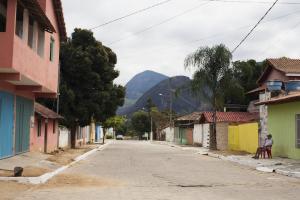 The majority of mantenopolitanos and cuparaquenses who migrate to Martha’s Vineyard do so for the prospect of improving their economic situation, but the emotional dimension is also an important aspect. Guilherme’s emotional comparison of Martha’s Vineyard and Mantenópolis, quoted above, is “bifocal.” In my study I use bifocality as a way to explore how Brazilians navigate their experiences on Martha’s Vineyard relative to their birth towns of Cuparaque and Mantenópolis. Through their ability to relate to one location while living in the other, they develop a perspective that includes a focus on both their origins and their future, on “rooting and routing.”
The majority of mantenopolitanos and cuparaquenses who migrate to Martha’s Vineyard do so for the prospect of improving their economic situation, but the emotional dimension is also an important aspect. Guilherme’s emotional comparison of Martha’s Vineyard and Mantenópolis, quoted above, is “bifocal.” In my study I use bifocality as a way to explore how Brazilians navigate their experiences on Martha’s Vineyard relative to their birth towns of Cuparaque and Mantenópolis. Through their ability to relate to one location while living in the other, they develop a perspective that includes a focus on both their origins and their future, on “rooting and routing.”
Within the transnational process of maintaining a connection between their hometowns and Martha’s Vineyard, through remittances, travel, and social media, many mantenopolitanos and cuparaquenses develop a reality that is based on both locations simultaneously. They continue their customs of origin to overcome feelings of isolation on Martha’s Vineyard, while familiarizing themselves with the life dynamics of the island and finding a place where they fit in. Bifocality is a dual frame of reference in which migrants find a sense of belonging in both Brazil and Martha’s Vineyard, reshaping their reality and goals and causing them to consider a life that is beyond one location or the other.
Sasha Iammarino graduated in May with a Bachelor of Arts in International Studies (World Studies Program) and a Plan in anthropology and photography, specifically on the sending and receiving travel patterns of Brazilians on Martha’s Vineyard. She plans to continue her research in Brazil and the U.S.
Spirits and Memory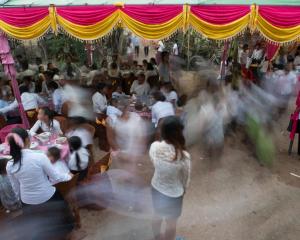 “The narratives of people who lived through the Khmer Rouge era and resettled in the United States are characterized by disruption and displacement,” says Emily Tatro, who also completed a Plan on the emigrant experience. She explored the medical and spiritual beliefs of Cambodians and Cambodian Americans, a population profoundly affected by political tumult, violence, and war. “Spirits deeply impact emigrants, altering the linearity of time and infiltrating the porousness of memory,” says Emily. “Spirits speak to the often-silenced ruptures, absences, and losses that characterize emigrants’ experiences.” Emily conducted her research fully aware that the stories she collected rested on social, political, and cosmological ground that continues to shift, and aware of her own biases as an outsider. “I include my own stories to remind me of my inescapable subjectivity.” Photo by John Willis
“The narratives of people who lived through the Khmer Rouge era and resettled in the United States are characterized by disruption and displacement,” says Emily Tatro, who also completed a Plan on the emigrant experience. She explored the medical and spiritual beliefs of Cambodians and Cambodian Americans, a population profoundly affected by political tumult, violence, and war. “Spirits deeply impact emigrants, altering the linearity of time and infiltrating the porousness of memory,” says Emily. “Spirits speak to the often-silenced ruptures, absences, and losses that characterize emigrants’ experiences.” Emily conducted her research fully aware that the stories she collected rested on social, political, and cosmological ground that continues to shift, and aware of her own biases as an outsider. “I include my own stories to remind me of my inescapable subjectivity.” Photo by John Willis
Good Fortune Next Time
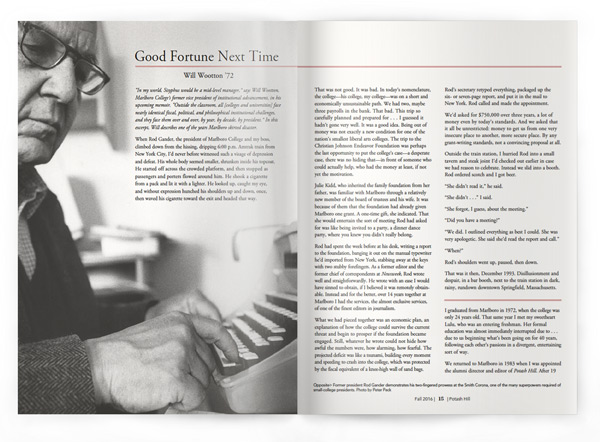
By Will Wootton ’72
“In my world, Sisyphus would be a mid-level manager,” says Will Wootton, Marlboro College’s former vice president of institutional advancement, in his upcoming memoir. “Outside the classroom, all [colleges and universities] face nearly identical fiscal, political, and philosophical institutional challenges, and they face them over and over, by year, by decade, by president.” In this excerpt, Will describes one of the years Marlboro skirted disaster.
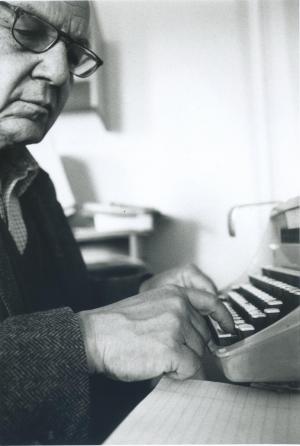 When Rod Gander, the president of Marlboro College and my boss, climbed down from the hissing, dripping 6:00 p.m. Amtrak train from New York City, I’d never before witnessed such a visage of depression and defeat. His whole body seemed smaller, shrunken inside his topcoat. He started off across the crowded platform, and then stopped as passengers and porters flowed around him. He shook a cigarette from a pack and lit it with a lighter. He looked up, caught my eye, and without expression hunched his shoulders up and down, once, then waved his cigarette toward the exit and headed that way.
When Rod Gander, the president of Marlboro College and my boss, climbed down from the hissing, dripping 6:00 p.m. Amtrak train from New York City, I’d never before witnessed such a visage of depression and defeat. His whole body seemed smaller, shrunken inside his topcoat. He started off across the crowded platform, and then stopped as passengers and porters flowed around him. He shook a cigarette from a pack and lit it with a lighter. He looked up, caught my eye, and without expression hunched his shoulders up and down, once, then waved his cigarette toward the exit and headed that way.
That was not good. It was bad. In today’s nomenclature, the college—his college, my college—was on a short and economically unsustainable path. We had two, maybe three payrolls in the bank. That bad. This trip so carefully planned and prepared for . . . I guessed it hadn’t gone very well. It was a good idea. Being out of money was not exactly a new condition for one of the nation’s smallest liberal arts colleges. The trip to the Christian Johnson Endeavor Foundation was perhaps the last opportunity to put the college’s case—a desperate case, there was no hiding that—in front of someone who could actually help, who had the money at least, if not yet the motivation.
Julie Kidd, who inherited the family foundation from her father, was familiar with Marlboro through a relatively new member of the board of trustees and his wife. It was because of them that the foundation had already given Marlboro one grant. A one-time gift, she indicated. That she would entertain the sort of meeting Rod had asked for was like being invited to a party, a dinner dance party, where you knew you didn’t really belong.
Rod had spent the week before at his desk, writing a report to the foundation, banging it out on the manual typewriter he’d imported from New York, stabbing away at the keys with two stubby forefingers. As a former editor and the former chief of correspondents at Newsweek, Rod wrote well and straightforwardly. He wrote with an ease I would have sinned to obtain, if I believed it was remotely obtainable. Instead and for the better, over 14 years together at Marlboro I had the services, the almost exclusive services, of one of the finest editors in journalism.
What we had pieced together was an economic plan, an explanation of how the college could survive the current threat and begin to prosper if the foundation became engaged. Still, whatever he wrote could not hide how awful the numbers were, how alarming, how fearful. The projected deficit was like a tsunami, building every moment and speeding to crash into the college, which was protected by the fiscal equivalent of a knee-high wall of sand bags.
Rod’s secretary retyped everything, packaged up the six- or seven-page report, and put it in the mail to New York. Rod called and made the appointment.
We’d asked for $750,000 over three years, a lot of money even by today’s standards. And we asked that it all be unrestricted: money to get us from one very insecure place to another, more secure place. By any grant-writing standards, not a convincing proposal at all.
Outside the train station, I hurried Rod into a small tavern and steak joint I’d checked out earlier in case we had reason to celebrate. Instead we slid into a booth. Rod ordered scotch and I got beer.
“She didn’t read it,” he said.
“She didn’t . . .” I said.
“She forgot, I guess, about the meeting.”
“Did you have a meeting?”
“We did. I outlined everything as best I could. She was very apologetic. She said she’d read the report and call.”
“When?” Rod’s shoulders went up, paused, then down.
That was it then, December 1993. Disillusionment and despair, in a bar booth, next to the train station in dark, rainy, rundown downtown Springfield, Massachusetts.
***
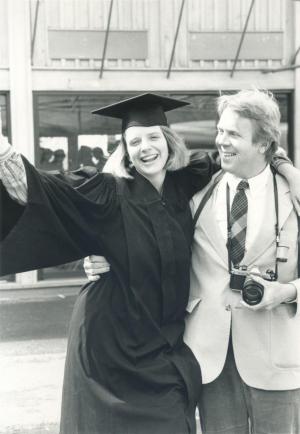 I graduated from Marlboro in 1972, when the college was only 24 years old. That same year I met my sweetheart Lulu, who was an entering freshman. Her formal education was almost immediately interrupted due to . . . due to us beginning what’s been going on for 40 years, following each other’s passions in a divergent, entertaining sort of way.
I graduated from Marlboro in 1972, when the college was only 24 years old. That same year I met my sweetheart Lulu, who was an entering freshman. Her formal education was almost immediately interrupted due to . . . due to us beginning what’s been going on for 40 years, following each other’s passions in a divergent, entertaining sort of way.
We returned to Marlboro in 1983 when I was appointed the alumni director and editor of Potash Hill. After 19 years there I was vice president of institutional advancement and Marlboro had grown from a perilously low 167 students to just over 300.
Among independent colleges and universities, there are financially shaky ones: old, settled in their ways, and constantly aging badly. There are colleges newly born, others approaching adolescence, and still others finally nearing something like adulthood after 70 or 80 years of hard living. There are huge 20,000-student universities, and colleges with thousands of undergraduates, and finally there are tiny places like Marlboro, shrews dodging the footfalls of dinosaurs.
Marlboro and Sterling College in northern Vermont, where I served as president from 2006 to 2012 and where there are just over 100 students, are distinguished not only by their size but also by their unusual curricula, their history, place, and people. It hardly matters, in one sense, because in the context of American higher education each is unknown, underendowed, underfunded, and, worst of all, practically unimaginable to the general college aspirant: a whole college considerably smaller than your high school graduating class. How could that be?
Each is further notable for having more than once skirted dangerously close to the sheer cliff edge of institutional oblivion. Today both remain small, so tiny that anyone who claims to know anything about higher education—and there are millions who do—would predict their near-immediate demise with an air of complete assurance, simply because of their obscurity and ridiculous, uneconomical, and clearly unsustainable size.
Marlboro (somewhat erratically) and Sterling (somewhat compulsively) have spent a lot of their time figuring out how to stay small, how not to grow. They understand, as do some other Vermont colleges, that the diseconomy of scale is not the primary threat; that there are other, equally forbidding threats out there, including fiscal mismanagement, legal claims, lack of critical resources, shortfalls in admissions, board dysfunction, inept leadership, and increases in regulatory burden coinciding with any of the above. If it were as simple as being small, they all would have succumbed decades ago, and this memoir would not exist.
Among the couple thousand independent liberal arts colleges, the Ivies and the potted Ivies are cushioned by enormous endowments and their own gold-plated histories, shaped from studiously cultivated alumni, their alumni parents, and alumni children. There must be another thousand regional institutions, including faith-based colleges and universities, that are fiscally and institutionally sound and have been for generations.
Death and its dismissive cousin, death-by-merger, is reserved for the old and infirm, the shrinking, the undernourished, the timid, and for the young, the experimental, and specialized. To this segment of the industry, death visits quite often, especially in New England, where the college-going population has been in decline off and on for 20 years, while the competition from state institutions and for-profit colleges has surged.
In Vermont, Windham College succumbed in the early ’80s, as did the fledgling Mark Hopkins College before the decade was out, then Trinity in 2000, and Woodbury in 2008; in Massachusetts, Atlantic Union College closed in 2011 and Urban College of Boston in 2012; and in 2012 New Hampshire’s Chester College went under. Famously, Antioch, in Ohio, succumbed after more than a century (it reopened after some years, unaccredited and struggling). Recently Sweet Briar announced its closure, but the alumni rescued it, at least for the short term, and Burlington College closed its doors just this year.
For me, there’s a critical aspect to endemic institutional fragility: that for some of us, in some perverse way, it is the odds against a future that makes it all worthwhile, that justifies spending one’s effective working years at worthy places that, to express it gently, are not assured the level of stability enjoyed by their wealthier and better known partners in the higher education world.
***
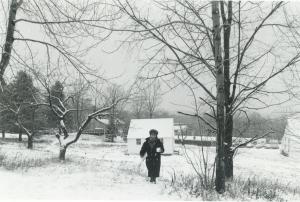 Rod came into my office at Marlboro, down the hall from his, and plopped into the red, as opposed to green, chair. It had been days since we drove back from Springfield to Vermont and began waiting for Julie Kidd to call.
Rod came into my office at Marlboro, down the hall from his, and plopped into the red, as opposed to green, chair. It had been days since we drove back from Springfield to Vermont and began waiting for Julie Kidd to call.
I was typing a story for the alumni magazine, Potash Hill. I didn’t turn around.
“She called.” I stopped typing.
“She read it. She’s going to do the whole thing: $250,000 a year for three years. Unrestricted.”
The tsunami disappeared like fog does, like it was never seriously there. I turned around and saw Rod practically floating from the weight off his shoulders. He was grinning. He started to sing, holding up his palms—he knew the words to hundreds of tunes, from the ’20s to the mid-’50s: “We’re in the money / The sky is sunny / Old man depression, you are through.”
“Yes,” I said. “That’s great. But what have you done today to save the place?”
“Not a thing,” he said. “I’m waiting for tomorrow when I tell the board we’re halfway to a balanced budget. And it’s only November. It reminds me of the newspaper hawker in Chicago. We’ll have to send him to another corner.”
“What hawker?”
“Whatever the headlines were, he stuck with only one call, over and over, for years: ‘Many Dead, Many Dying! Many Dead, Many Dying!’”
Will Wootton retired in 2012 after serving as president of Sterling College for six years, when he “ran out of things to do, stuff to fix, nearby streams to fish.” This article is excerpted and adapted from Will’s memoir, Good Fortune Next Time: Life, Death, Irony, and the Administration of Very Small Colleges, due to be released by Dryad Press in fall 2017. The same chapter in full, titled “Many Dead, Many Dying,” was previously excerpted in Santa Fe Writer’s Project Quarterly Issue 5, Spring 2016.
From Round Earth to Flat Hierarchies
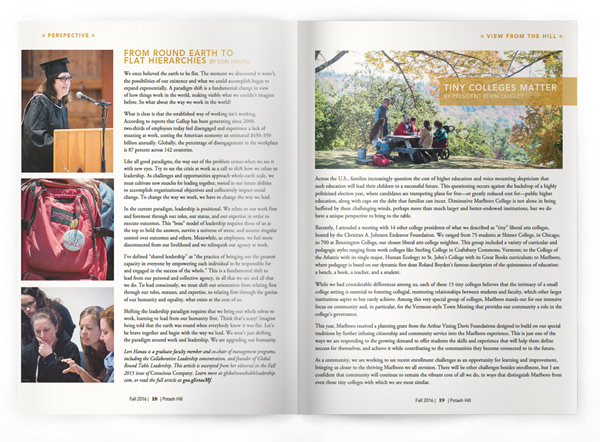
By Lori Hanau
 We once believed the earth to be flat. The moment we discovered it wasn’t, the possibilities of our existence and what we could accomplish began to expand exponentially. A paradigm shift is a fundamental change in view of how things work in the world, making visible what we couldn’t imagine before. So what about the way we work in the world?
We once believed the earth to be flat. The moment we discovered it wasn’t, the possibilities of our existence and what we could accomplish began to expand exponentially. A paradigm shift is a fundamental change in view of how things work in the world, making visible what we couldn’t imagine before. So what about the way we work in the world?
What is clear is that the established way of working isn’t working. According to reports that Gallup has been generating since 2000, two-thirds of employees today feel disengaged and experience a lack of meaning at work, costing the American economy an estimated $450–550 billion annually. Globally, the percentage of disengagement in the workplace is 87 percent across 142 countries.
Like all good paradigms, the way out of the problem comes when we see it with new eyes. Try to see the crisis at work as a call to shift how we relate to leadership. As challenges and opportunities approach whole-earth scale, we must cultivate new muscles for leading together, rooted in our innate abilities to accomplish organizational objectives and collectively impact social change. To change the way we work, we have to change the way we lead.
In the current paradigm, leadership is positional. We relate to our work first and foremost through our roles, our status, and our expertise in order to execute outcomes. This “boss” model of leadership requires those of us at the top to hold the answers, survive a universe of stress, and assume singular control over outcomes and others. Meanwhile, as employees, we feel more disconnected from our livelihood and we relinquish our agency at work.
I’ve defined “shared leadership” as “the practice of bringing out the greatest capacity in everyone by empowering each individual to be responsible for and engaged in the success of the whole.” This is a fundamental shift to lead from our personal and collective agency, in all that we are and all that we do. To lead consciously, we must shift our orientation from relating first through our roles, statuses, and expertise, to relating first through the genius of our humanity and equality, what exists at the core of us.
Shifting the leadership paradigm requires that we bring our whole selves to work, learning to lead from our humanity first. Think that’s scary? Imagine being told that the earth was round when everybody knew it was flat. Let’s be brave together and begin with the way we lead. We aren’t just shifting the paradigm around work and leadership. We are upgrading our humanity.
Lori Hanau is a graduate faculty member and co-chair of management programs, including the Collaborative Leadership concentration, and founder of Global Round Table Leadership. This article is excerpted from her editorial in the Fall 2015 issue of Conscious Company. Learn more at globalroundtableleadership.com.
Tiny Colleges Matter
By President Kevin Quigley
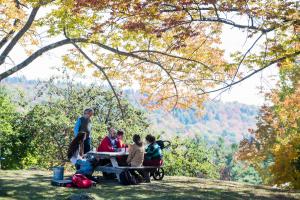 Across the U.S., families increasingly question the cost of higher education and voice mounting skepticism that such education will lead their children to a successful future. This questioning occurs against the backdrop of a highly politicized election year, where candidates are trumpeting plans for free—or greatly reduced cost for—public higher education, along with caps on the debt that families can incur. Diminutive Marlboro College is not alone in being buffeted by these challenging winds, perhaps more than much larger and better-endowed institutions, but we do have a unique perspective to bring to the table.
Across the U.S., families increasingly question the cost of higher education and voice mounting skepticism that such education will lead their children to a successful future. This questioning occurs against the backdrop of a highly politicized election year, where candidates are trumpeting plans for free—or greatly reduced cost for—public higher education, along with caps on the debt that families can incur. Diminutive Marlboro College is not alone in being buffeted by these challenging winds, perhaps more than much larger and better-endowed institutions, but we do have a unique perspective to bring to the table.
Recently, I attended a meeting with 14 other college presidents of what we described as “tiny” liberal arts colleges, hosted by the Christian A. Johnson Endeavor Foundation. We ranged from 75 students at Shimer College, in Chicago, to 700 at Bennington College, our closest liberal arts college neighbor. This group included a variety of curricular and pedagogic styles ranging from work colleges like Sterling College in Craftsbury Commons, Vermont; to the College of the Atlantic with its single major, Human Ecology; to St. John’s College with its Great Books curriculum; to Marlboro, where pedagogy is based on our dynamic first dean Roland Boyden’s famous description of the quintessence of education: a bench, a book, a teacher, and a student.
While we had considerable differences among us, each of these 15 tiny colleges believes that the intimacy of a small college setting is essential to fostering collegial, mentoring relationships between students and faculty, which other larger institutions aspire to but rarely achieve. Among this very special group of colleges, Marlboro stands out for our intensive focus on community and, in particular, for the Vermont-style Town Meeting that provides our community a role in the college’s governance.
This year, Marlboro received a planning grant from the Arthur Vining Davis Foundations designed to build on our special traditions by further infusing citizenship and community service into the Marlboro experience. This is just one of the ways we are responding to the growing demand to offer students the skills and experience that will help them define success for themselves, and achieve it while contributing to the communities they become connected to in the future.
As a community, we are working to see recent enrollment challenges as an opportunity for learning and improvement, bringing us closer to the thriving Marlboro we all envision. There will be other challenges besides enrollment, but I am confident that community will continue to remain the vibrant core of all we do, in ways that distinguish Marlboro from even those tiny colleges with which we are most similar.
On & Off the Hill
Finding Common Ground in the Wilds
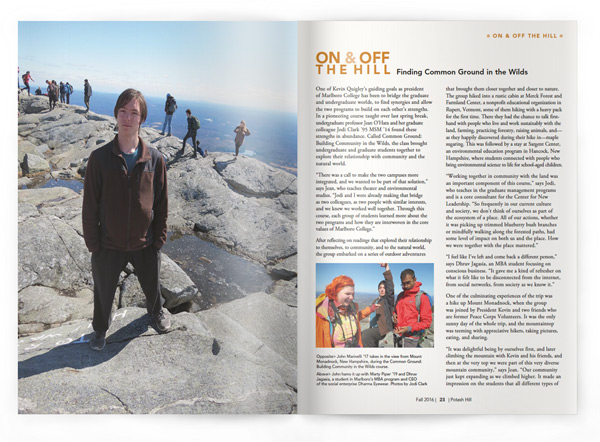
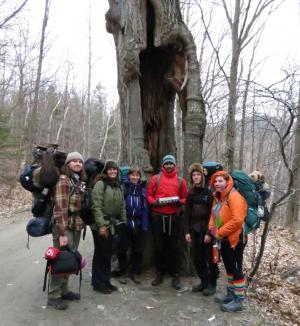 One of Kevin Quigley’s guiding goals as president of Marlboro College has been to bridge the graduate and undergraduate worlds, to find synergies and allow the two programs to build on each other’s strengths. In a pioneering course taught over last spring break, undergraduate professor Jean O’Hara and her graduate colleague Jodi Clark ’95 MSM ’14 found these strengths in abundance. Called Common Ground: Building Community in the Wilds, the class brought undergraduate and graduate students together to explore their relationship with community and the natural world.
One of Kevin Quigley’s guiding goals as president of Marlboro College has been to bridge the graduate and undergraduate worlds, to find synergies and allow the two programs to build on each other’s strengths. In a pioneering course taught over last spring break, undergraduate professor Jean O’Hara and her graduate colleague Jodi Clark ’95 MSM ’14 found these strengths in abundance. Called Common Ground: Building Community in the Wilds, the class brought undergraduate and graduate students together to explore their relationship with community and the natural world.
“There was a call to make the two campuses more integrated, and we wanted to be part of that solution,” says Jean, who teaches theater and environmental studies. “Jodi and I were already making that bridge as two colleagues, as two people with similar interests, and we knew we worked well together. Through this course, each group of students learned more about the two programs and how they are interwoven in the core values of Marlboro College.”
After reflecting on readings that explored their relationship to themselves, to community, and to the natural world, the group embarked on a series of outdoor adventures that brought them closer together and closer to nature. The group hiked into a rustic cabin at Merck Forest and Farmland Center, a nonprofit educational organization in Rupert, Vermont, some of them hiking with a heavy pack for the first time. There they had the chance to talk firsthand with people who live and work sustainably with the land, farming, practicing forestry, raising animals, and— as they happily discovered during their hike in—maple sugaring. This was followed by a stay at Sargent Center, an environmental education program in Hancock, New Hampshire, where students connected with people who bring environmental science to life for school-aged children.
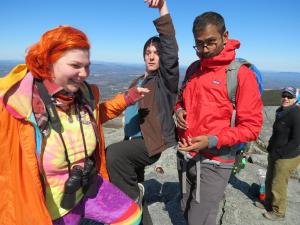 Working together in community with the land was an important component of this course,” says Jodi, who teaches in the graduate management programs and is a core consultant for the Center for New Leadership. “So frequently in our current culture and society, we don’t think of ourselves as part of the ecosystem of a place. All of our actions, whether it was picking up trimmed blueberry bush branches or mindfully walking along the forested paths, had some level of impact on both us and the place. How we were together with the place mattered.”
Working together in community with the land was an important component of this course,” says Jodi, who teaches in the graduate management programs and is a core consultant for the Center for New Leadership. “So frequently in our current culture and society, we don’t think of ourselves as part of the ecosystem of a place. All of our actions, whether it was picking up trimmed blueberry bush branches or mindfully walking along the forested paths, had some level of impact on both us and the place. How we were together with the place mattered.”
“I feel like I’ve left and come back a different person,” says Dhruv Jagasia, an MBA student focusing on conscious business. “It gave me a kind of refresher on what it felt like to be disconnected from the internet, from social networks, from society as we know it.”
One of the culminating experiences of the trip was a hike up Mount Monadnock, when the group was joined by President Kevin and two friends who are former Peace Corps Volunteers. It was the only sunny day of the whole trip, and the mountaintop was teeming with appreciative hikers, taking pictures, eating, and sharing.
“It was delightful being by ourselves first, and later climbing the mountain with Kevin and his friends, and then at the very top we were part of this very diverse mountain community,” says Jean. “Our community just kept expanding as we climbed higher. It made an impression on the students that all different types of people worked their way up this difficult climb and that the president took the time to be with them for a full day’s hike.”
A Fresh Look at Curriculum
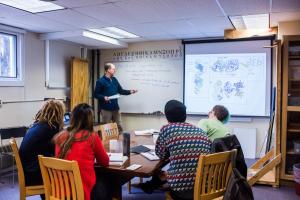 Marlboro understandably takes pride in an academic program rich with interdisciplinary possibilities and supportive of the intellectual passions of its students. In the interest of that ongoing support, the faculty have been looking critically at the curriculum, leading to exciting initiatives that will be evolving and unfolding over the coming years. One of these is an elective course on living and working in community, introduced as a pilot this fall. The other has to do with making a clearer and more consistent “progression” from the sophomore year to being “on Plan.”
Marlboro understandably takes pride in an academic program rich with interdisciplinary possibilities and supportive of the intellectual passions of its students. In the interest of that ongoing support, the faculty have been looking critically at the curriculum, leading to exciting initiatives that will be evolving and unfolding over the coming years. One of these is an elective course on living and working in community, introduced as a pilot this fall. The other has to do with making a clearer and more consistent “progression” from the sophomore year to being “on Plan.”
“These are both initiatives that are still in progress but that signal a move toward better integration between what we say we do, what we actually do, and what we aspire to do,” says Brenda Foley, theater professor and member of the Renaissance Group, which coordinated the initiatives.
“The Progression is the most complete and sweeping change to come out of this movement of review and reform,” said John Sheehy, literature and writing professor and another member of the Renaissance Group. “It is the result of some pretty serious rethinking of our advising model, and it enacts substantive changes in practice over the next couple of years.”
As it stands, the Progression is a proposed benchmark event that will help structure and solidify the transition from the first two years to the second two years at Marlboro. Supported by the building of a student portfolio starting on day one, and informed by the sophomore review, the Progression is a conversation between students and their advisors from which the preliminary Plan application emerges. The idea is to give this crucial period of transition more definition, while allowing for a range of approaches deemed valuable to individual faculty members and students.
“Although this will take some time to implement, it is an important beginning,” says John. “The process has been a valuable time for the faculty to put their hands under the hood and see what works. The point was never to ‘fix’ the college—the point was to re-engage, as faculty, with the curriculum. That we have done, and that we must continue to do.” Look for an article on the new course on living and working in community in the next issue of Potash Hill.
College Partners with ILI
 “One of the biggest barriers to international students attending Marlboro College is the high proficiency in English needed to engage in academic scholarship,” says Maggie Strassman, director of international studies. That is changing, following a new partnership with the International Language Institute of Massachusetts (ILI), a Northampton-based, not-for-profit language school promoting intercultural understanding through language instruction.
“One of the biggest barriers to international students attending Marlboro College is the high proficiency in English needed to engage in academic scholarship,” says Maggie Strassman, director of international studies. That is changing, following a new partnership with the International Language Institute of Massachusetts (ILI), a Northampton-based, not-for-profit language school promoting intercultural understanding through language instruction.
Through an agreement signed by Marlboro and ILI in March, international students from around the world who need an English-language intensive program can start at ILI and then continue on at Marlboro to complete their education. Marlboro requires a TOEFL (Test of English as a Foreign Language) score of 90, among the highest proficiency requirements of cohort colleges, and ILI will make this more accessible.
“This is a perfect match,” says Brigid Lawler, dean of admissions. “ILI’s well-deserved reputation for excellence in teaching English skills as well as the nuances of U.S. academic culture assures that our students will have a better chance at success.”
“We are extremely pleased to welcome Marlboro College as the 12th partner in our University Pathways Program,” said ILI executive director Caroline Gear, who extolled Marlboro’s beautiful rural setting. “It is an ideal spot for international students seeking degrees in the United States from a very reputable college, and who also want to experience U.S. culture outside of large urban areas.”
ILI’s University Pathway Program includes a range of selected colleges and universities, each of which offers academic courses that are of interest to international students. Other partners include Bay Path University, Boston Architectural College, Elms College, Greenfield Community College, Lasell College, Paul Smith’s College, School for International Training, Springfield College, Western New England University, Westfield State University, and University of Massachusetts-Amherst Graduate School. Marlboro is the smallest partner institution, and as such shares many characteristics with ILI.
“We have a lot in common with ILI, in terms of our campus culture and educational philosophy, and this will be a very natural progression for many students coming to us from overseas,” says Maggie. “Not only does ILI provide international students with the kind of language training that can help them succeed in a challenging liberal arts curriculum, it also provides an introduction to the academic culture of an American college experience, which is so crucial for success here.”
Movies from Marlboro Takes On the Not-Too-Distant Future
“Wetware marks a departure for me,” says Marlboro film professor and director Jay Craven, referring to the most recent production of his Movies from Marlboro semester intensive. “My earlier films are all set in the past, working with Faulkner’s and T.S. Eliot’s ideas that ‘the past is always present.’ Now we’re looking to see, in our era of instant communication and a sometimes fading sense of history, whether the future is also present. Of course, it is.”
Marking the third Movies from Marlboro intensive, 24 professionals mentored and collaborated with 30 students from a dozen colleges to shoot Wetware last spring semester at three locations: Brattleboro and Burlington in Vermont, and Nantucket in Massachusetts. Now in postproduction, Wetware is scheduled for release this fall.
Based on the novel by Guggenheim Fellowship–winning writer Craig Nova, Wetware is set in a not-too-distant future where a cutting-edge genetic engineering firm alters clients to help them cope with the most reviled jobs. When a pair of experimental prototypes escape into a volatile and dangerous world, their creator scrambles to track them down and makes a provocative discovery that will change everything.
“We’re excited to be making this Vermont/Nantucket noir—our first production that splits locations between northern and southern New England,” says Jay. “The truth is that the place in this film is more fictional than any film I’ve made. This is one reason that our invented visual palette becomes so important. Yes, the uniqueness of Vermont towns and Nantucket streets and beaches will shine through, but our job here is to knit and blend and draw from natural assets that inform our own vision.”
The cast of Wetware includes a mix of Hollywood and Broadway veterans, emerging talent, and New England actors, starring Jerry O’Connell, Morgan Wolk, Cameron Scoggins, Bret Lada, Nicole Shalhoub, Garret Lee Hendricks, John Rothman, and Susan McGinnis. A professional crew worked with students from Wellesley College, University of California at Berkeley, Wesleyan University, Augsburg College, Mount Holyoke College, Sarah Lawrence College, University of Maine, Colby Sawyer College, Simmons College, Lyndon State College, Fitchburg State University, and of course Marlboro College.
Movies from Marlboro was established in 2012 and has produced two films to date, Northern Borders in 2012 and Peter and John in 2014. Inspired by pioneering Vermont educator John Dewey’s call for intensive learning that enlarges meaning “through shared experience and joint action,” the biennial program is unique in the nation. “Within the hyper-commercialized media industry, we work to combine transformative experiential learning, community engagement, and our best hope for sustainable place-based independent film production and regional release,” says Jay.
Campus Gets a Taste of “Real Food”
By Kristen Thompson ’18
In April 2014 former president Ellen McCulloch-Lovell and Benjamin Newcomb, then Marlboro’s chef manager, signed the Real Food Campus Commitment, making Marlboro’s dining services the first branch of Metz Culinary Management to take on the challenge (see Potash Hill, Fall 2014). Since then, the real struggle has been trying to meet the 20 percent “real food” quota by 2020.
The Real Food Challenge (RFC) is a national program with the goal of directing more than $1 billion of university money spent on food toward food that is “real” (ethically, locally, and/or healthily produced). Since signing on in 2014, Marlboro College has made strides in sourcing food from companies that treat their livestock better and give their employees fair wages and safe working conditions. This fall semester chemistry professor Todd Smith is introducing Searching for Food Justice, a class geared directly toward assessing the college’s food purchases based on “real food” criteria. But there are still challenges.
“We’ve established curricular support and have a working team in place within a committee on campus, but more work is needed to identify peer leaders and support their involvement with the RFC,” says Ben, now food services manager. “The new guidelines and criteria were recently updated; it’s time to launch the calculator and start using our updated Real Food Policy as part of that effort.”
Marlboro’s beverages exemplify the college’s efforts to invest in fair food. The dining hall and Potash Grill buy all of their coffee from Mocha Joe’s, which works directly with communities in Cameroon where coffee is grown. They pay the people working there fairly, and money goes back into the local communities, in some cases contributing to the building of churches and schools. Black River Produce is one of Marlboro’s key sources for humanely raised meat with neither hormones nor antibiotics, from the grass-fed burgers in the grill to the local bacon, and even some of the chicken served on campus.
“The dining staff are beginning work on a special local farm-to-table menu to facilitate more real, local, sustainable food than ever despite our budgetary challenges,” says Ben. “We recently rejoined Windham Farm and Food, sourcing 100 percent real food daily from over 84 hyper local farms with an aggregation and delivery service. The farmers are marketing directly to us, greatly improving our access to locally grown and produced items for our menus.”
Despite these significant gains, community involvement remains challenging—it has been difficult to make the Real Food Challenge enticing with so many other academic and extracurricular projects pursued by such a small school population. While efforts were made throughout the last spring semester to encourage students to get involved, the bulk of the work fell to a few individuals.
“In order to make the Real Food Challenge stronger on campus, we need more education for all involved,” says Brian Newcomb, Potash Grill manager. He asserts that if more of the Marlboro community knows about the Real Food Challenge, they may be able to point the kitchen staff to other “real” food sources. “The more they know, the more they can speak up. The more they speak up, the more we can instill change.”
Community Engagement at Pine Ridge
By Noah Strauss Jenkins ’18
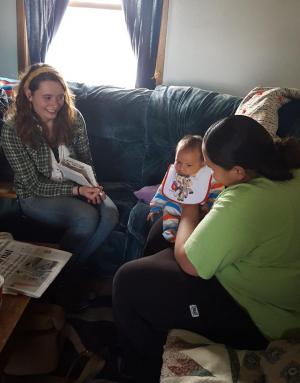 Over spring break last April, photography professor John Willis and a group of students traveled to the Pine Ridge Reservation, in South Dakota, a continuation of the close relationship John has maintained with the Oglala Lakota Sioux community there for 25 years. He says there has been a tendency for outsiders to come into the reservation with big promises that they never make good on, making the community wary, so the group focused on helping where they could and meeting people through that process.
Over spring break last April, photography professor John Willis and a group of students traveled to the Pine Ridge Reservation, in South Dakota, a continuation of the close relationship John has maintained with the Oglala Lakota Sioux community there for 25 years. He says there has been a tendency for outsiders to come into the reservation with big promises that they never make good on, making the community wary, so the group focused on helping where they could and meeting people through that process.
“We met a lot of amazing people, and had a lot of amazing experiences that I believe were very eye-opening for everyone,” says John. “Marlboro students were doing collaborative community engagement, where you are there to work with the community, rather than just coming by and trying to save ‘people in need.’ They had a clear awareness that they would benefit from the experience more than those they went to work with, but did what they could to make it useful for all.”
“For me the trip was focused more on connecting with the people who live there, and learning about their lives and the challenges that come with living there,” says junior Chris Lamb, one of the six students who participated. “The history of how they were forced onto ‘the rez’ by whites was something that was always present in my mind. It was also about the beauty that still lives there, in their families and communities.”
The trip was designed to teach students about modes of service and Lakota culture, and to show that the culture on the reservation is very dynamic despite being one of the poorest communities in America. Students met with families and elders to talk about the politics surrounding their land, gender roles, and family traditions, and also had the opportunity to meet with spiritual leaders and participate in ceremonies.
“We loved being able to spend time with families in their homes, and having the opportunity to really try and see into their lives,” says junior Cait Mazzarela. “They were really open, and shared a lot about their beliefs and lives, and it’s amazing to be able to get an inside look.”
The students raised money to make the trip possible for each of them, regardless of their ability to pay, and had enough extra to donate funds to several programs they were involved with there. One of these is B.E.A.R. (Be Excited About Reading), an after-school program working with suicide prevention and giving youth better alternatives, including counseling efforts, academic help, sporting opportunities, and healthy snacks for youth. The students also assisted the tribal radio station with fundraising and helped the high school set up a student online newsletter, including buying three cameras for their use.
Another way the group decided to assist the B.E.A.R. project was through skateboarding, which has proven to be a respected alternative for youth on the reservation. The tribe has built an impressive skate park for this purpose, but most of the equipment they have available is poor quality. Marlboro College staff carpenter Brent Johnston used his connections in the skateboarding world to access quality equipment, at cost, from a manufacturer. The group purchased several sets of boards and helmets, aided by personal contributions from Brent, President Kevin Quigley, and Plant and Operations Director Dan Cotter.
In each case, the students responded directly to the needs that were presented, collaborating with a community that was still deeply immersed in their culture and tradition. “Underneath the struggles we hear about, there is a lot of resilience and pride in their traditional ways,” says John. “There are a lot of strong and motivated people trying to do good out there, trying to save their culture, a culture filled with beliefs and practices we all would benefit from understanding.”
Also of Note
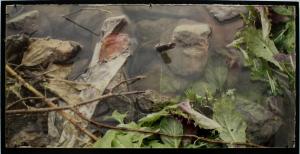 “Although I will always look at the beauty of nature in my work, I also hope to reveal a truth beyond it,” says Hilary Baker, multimedia resource specialist. Hilary shared some her new work in a Drury Gallery show last February, called Water Reconnect, and then again at the grad school for “gallery walk” in June. Her work offers deeply layered images that integrate the alternative with the digital, exploring our multifaceted relationships with water. See more at studiohb-digitalarts.squarespace.com.
“Although I will always look at the beauty of nature in my work, I also hope to reveal a truth beyond it,” says Hilary Baker, multimedia resource specialist. Hilary shared some her new work in a Drury Gallery show last February, called Water Reconnect, and then again at the grad school for “gallery walk” in June. Her work offers deeply layered images that integrate the alternative with the digital, exploring our multifaceted relationships with water. See more at studiohb-digitalarts.squarespace.com.
An MBA student with a concentration in mission-driven organizations, Chris Meehan was selected for the prestigious Annie E. Casey Foundation’s Results Based Leadership Development program. Chris was one of 20 participants chosen nationally for the program, which includes seven two-day, in-person intensives all around the country. “The program will be focusing on our Collective Impact work in Vermont, which is a part of a larger pilot project of Feeding America called Collaborating for Clients (C4C),” says Chris, the chief community impact officer for the Vermont Foodbank.
In March, Felix Jarrar ’16 presented a paper at the Bowling Green State University Graduate Student Conference for composers, titled “‘Die Lorelei’: an examination of three versions of Liszt’s text setting of Heine.” Based on his Plan of Concentration work, Felix’s paper considers Franz Liszt’s settings of Heinrich Heine’s poem and how they revise and transform musical material, both melodically and harmonically. “This paper examines how the most interesting and significant musical aspects of Liszt’s text setting come at the expense of the poetic content,” says Felix.
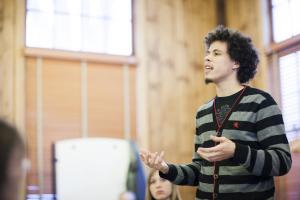 In February, in recognition of Black History Month, Marlboro sponsored a “community read” of Citizen: An American Lyric, by Claudia Rankine. James Turpin ’16 led a discussion of the book-length poem about race and the imagination, which Rankine called an attempt to “pull lyric back into its realities.” According to The New Yorker, “Those realities include the acts of everyday racism—remarks, glances, implied judgments—that flourish in an environment where more explicit acts of discrimination have been outlawed.”
In February, in recognition of Black History Month, Marlboro sponsored a “community read” of Citizen: An American Lyric, by Claudia Rankine. James Turpin ’16 led a discussion of the book-length poem about race and the imagination, which Rankine called an attempt to “pull lyric back into its realities.” According to The New Yorker, “Those realities include the acts of everyday racism—remarks, glances, implied judgments—that flourish in an environment where more explicit acts of discrimination have been outlawed.”
In June, Hillary Orsini (formerly Hillary Boone) shared her experience with results-based accountability (RBA) and nongovernment organizations in Vermont at Measurable Impact 2016, an RBA conference in Baltimore. This national conference was a unique opportunity for public and social sector leaders to explore the concepts and tools their peers around the world are using to improve performance and achieve community impact. The assistant director of the Center for New Leadership, Hillary has trained and coached hundreds of organizations across New England in the use of RBA.
Alumni have long known that when it comes to learning in a tight-knit classroom with fully engaged faculty, Marlboro College is second to none. In April, Marlboro was ranked number one for the lowest student-faculty ratio, coming in at 5-to-1, by U.S. News & World Report. It shared the list with 20 other colleges including such top-rated liberal arts schools as Williams, Amherst, Swarthmore, and Skidmore. Marlboro also had the lowest total undergraduate enrollment among the schools listed. Learn more.
In June, dining hall manager Ben Newcomb was presented with an exemplary service award at the Metz Culinary Management leadership conference. “Ben was chosen for this award because he exemplifies the values Metz represents,” says Cheryl McCann, vice president for human resources at Metz. “We feel as though Ben takes these values and translates them to action.” In addition to receiving a cash prize and engraved award, Ben is most excited about being selected to attend a three-day workshop in October that includes culinary training in Mediterranean and Latin cuisines with an award-winning chef.
The graduate and professional studies program introduced three new awards to attract the very best candidates: the Greater Good Award, recognizing students who have demonstrated a commitment to community through national service; the John Dewey Award, recognizing students who have served others through engaged teaching; and the Whetstone Fellowship, recognizing alumni of the undergraduate program. The fellowship acknowledges that Marlboro alumni are ideally suited to continue their education at the graduate school, where they will find a familiar focus on community, self-directed learning, and project-based work.
Town Meeting, on March 30, passed a resolution to support the designation of approximately 136 acres of Marlboro College’s forested lands north of campus as an ecological reserve. “It is the opinion of the Town Meeting that these lands will be a rare and valuable location for education and ecological research, an important forested area in a time of climate change, a unique college asset that will attract and retain community members, and perhaps most importantly, a haven for the community—its human and non-human members alike.” The language charged the Environmental Advisory Committee with presenting a detailed proposal to the Town Meeting and trustees by the end of 2016.
“Marlboro College parallels many of my values and beliefs in higher education,” says Luis Rosa, who joined the college in January as dean of students. “Although the college maintains a rigorous curriculum, there is a great effort to ensure a broad range of access to students.” Luis has 15 years of experience in student affairs leadership and administration, most recently as dean of community life at Antioch College in Yellow Springs, Ohio, and brings a style of leadership that is democratic and participatory, in keeping with Marlboro’s longstanding ideals.
The Distinguished Service Award for staff members in the spring semester went to two essential staff: Cheri Morris, housecleaning staff member for the undergraduate campus, and Mike Hutchins, maintenance staff member for the graduate campus. According to Cheri’s nomination, she “cleans like hell” and “we really appreciate the effort she puts into her work, and that she takes the time to be part of our community life.” Mike’s nomination says he has “taken upon himself to find, cultivate, and distribute flowering plants throughout the grad area.” Congratulations, Cheri and Mike.
Last March, five staff from Marlboro College Graduate and Professional Studies were chosen to present at the 2016 Women’s Leadership Conference, a two-day event sponsored by Vermont Women in Higher Education, in Killington, Vermont. Their participation raises Marlboro’s profile as an innovator for leadership development in the state. Marlboro staff presenters included: Kathy Urffer, associate registrar for graduate and professional studies; Julie Van der Horst Jansen, business manager for the Center for New Leadership (CNL); Beth Neher, capstone coordinator; Kim Lier, teaching and learning specialist for CNL; and Hillary Orsini, assistant director of CNL.
Polar Plunge
In March, 17 stalwart individuals experienced the “penultimate purification rite of passage on Potash Hill,” according to OP director Randy Knaggs (pictured).
Dance Fever
Kristen Thompson ’18, Karissa Wolivar ’19, Erin Huang-Shaffer ’18, Liana Nuse ’16, dance teacher Khady Malal Badji, Lucy Hammond ’18, and Cait Mazzarella ’18 prepare for a dance party/performance during a journey to Senegal in June, the culmination of a class called Dance in World Cultures. See a short video clip.
Sex Positive
Total Health Center office manager Celena Romo ’05 and student life coordinator Alison Trimmer mix it up in a game of “Consensual Twister” during a Sex Positivity Resource Fair in February, part of a month of activities focused on sex positivity.
Big Apple Art
Sabrina Konick ’19 and Trevor Asbury ’17 listen to visual arts faculty member Tim Segar at the Metropolitan Museum of Art during an action-packed weekend visit to New York art museums in April.
Tough Mudders
Cat Clauss ’17 crosses a rope bridge during a “mud run” all around campus in April, enjoyed by students, community members, and several participants from local Girls on the Run programs.
Events
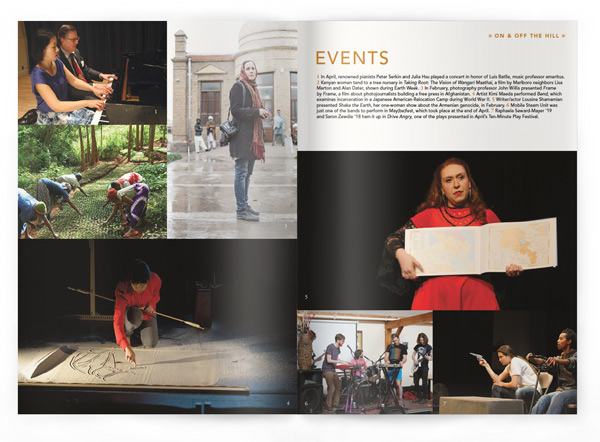
1 In April, renowned pianists Peter Serkin and Julia Hsu played a concert in honor of Luis Batlle, music professor emeritus. 2 Kenyan women tend to a tree nursery in Taking Root: The Vision of Wangari Maathai, a film by Marlboro neighbors Lisa Merton and Alan Dater, shown during Earth Week. 3 In February, photography professor John Willis presented Frame by Frame, a film about photojournalists building a free press in Afghanistan. 4 Artist Kimi Maeda performed Bend, which examines incarceration in a Japanese American Relocation Camp during World War II. 5 Writer/actor Lousine Shamamian presented Shake the Earth, her one-woman show about the Armenian genocide, in February. 6 Mobile Steam Unit was just one of the bands to perform in May(be)fest, which took place at the end of April. 7 Raphaela Seward-Mayer ’19 and Saron Zewdie ’18 ham it up in Drive Angry, one of the plays presented in April’s Ten-Minute Play Festival.
Focus on Faculty
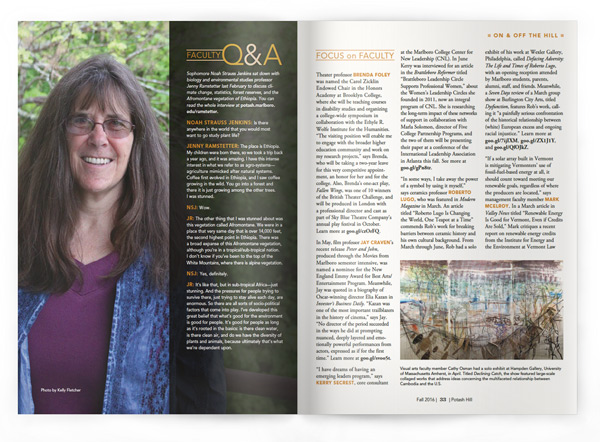
Faculty Q&A
Sophomore Noah Strauss Jenkins sat down with biology and environmental studies professor Jenny Ramstetter last February to discuss climate change, statistics, forest reserves, and the Afromontane vegetation of Ethiopia. You can read the whole interview.
Noah Stauss Jenkins: Is there anywhere in the world that you would most want to go study plant life?
Jenny Ramstetter: The place is Ethiopia. My children were born there, so we took a trip back a year ago, and it was amazing. I have this intense interest in what we refer to as agro-systems— agriculture mimicked after natural systems. Coffee first evolved in Ethiopia, and I saw coffee growing in the wild. You go into a forest and there it is just growing among the other trees. I was stunned.
NSJ: Wow.
JR: The other thing that I was stunned about was this vegetation called Afromontane. We were in a place that very same day that is over 14,000 feet, the second highest point in Ethiopia. There was a broad expanse of this Afromontane vegetation, although you’re in a tropical/sub-tropical nation. I don’t know if you’ve been to the top of the White Mountains, where there is alpine vegetation.
NSJ: Yes, definitely.
JR: It’s like that, but in sub-tropical Africa—just stunning. And the pressures for people trying to survive there, just trying to stay alive each day, are enormous. So there are all sorts of socio-political factors that come into play. I’ve developed this great belief that what’s good for the environment is good for people. It’s good for people as long as it’s rooted in the basics: is there clean water, is there clean air, and do we have the diversity of plants and animals, because ultimately that’s what we’re dependent upon.
Focus on Faculty
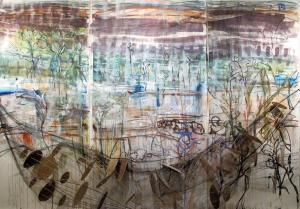 Theater professor Brenda Foley was named the Carol Zicklin Endowed Chair in the Honors Academy at Brooklyn College, where she will be teaching courses in disability studies and organizing a college-wide symposium in collaboration with the Ethyle R. Wolfe Institute for the Humanities. “The visiting position will enable me to engage with the broader higher education community and work on my research projects,” says Brenda, who will be taking a two-year leave for this very competitive appointment, an honor for her and for the college. Also, Brenda’s one-act play Fallen Wings was one of 10 winners of the British Theater Challenge, and will be produced in London with a professional director and cast as part of Sky Blue Theatre Company’s annual play festival in October. Learn more.
Theater professor Brenda Foley was named the Carol Zicklin Endowed Chair in the Honors Academy at Brooklyn College, where she will be teaching courses in disability studies and organizing a college-wide symposium in collaboration with the Ethyle R. Wolfe Institute for the Humanities. “The visiting position will enable me to engage with the broader higher education community and work on my research projects,” says Brenda, who will be taking a two-year leave for this very competitive appointment, an honor for her and for the college. Also, Brenda’s one-act play Fallen Wings was one of 10 winners of the British Theater Challenge, and will be produced in London with a professional director and cast as part of Sky Blue Theatre Company’s annual play festival in October. Learn more.
In May, film professor Jay Craven's recent release Peter and John, produced through the Movies from Marlboro semester intensive, was named a nominee for the New England Emmy Award for Best Arts/ Entertainment Program. Meanwhile, Jay was quoted in a biography of Oscar-winning director Elia Kazan in Investor’s Business Daily. “Kazan was one of the most important trailblazers in the history of cinema,” says Jay. “No director of the period succeeded in the ways he did at prompting nuanced, deeply layered and emotionally powerful performances from actors, expressed as if for the first time.” Learn more.
“I have dreams of having an emerging leaders program,” says Kerry Secrest, core consultant at the Marlboro College Center for New Leadership (CNL). In June Kerry was interviewed for an article in the Brattleboro Reformer titled “Brattleboro Leadership Circle Supports Professional Women,” about the Women’s Leadership Circles she founded in 2011, now an integral program of CNL. She is researching the long-term impact of these networks of support in collaboration with Marla Solomon, director of Five College Partnership Programs, and the two of them will be presenting their paper at a conference of the International Leadership Association in Atlanta this fall. Learn more.
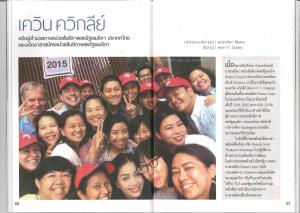 “In some ways, I take away the power of a symbol by using it myself,” says ceramics professor Roberto Lugo, who was featured in Modern Magazine in March. An article titled “Roberto Lugo Is Changing the World, One Teapot at a Time” commends Rob’s work for breaking barriers between ceramic history and his own cultural background. From March through June, Rob had a solo exhibit of his work at Wexler Gallery, Philadelphia, called Defacing Adversity: The Life and Times of Roberto Lugo, with an opening reception attended by Marlboro students, parents, alumni, staff, and friends. Meanwhile, a Seven Days review of a March group show at Burlington City Arts, titled Dysfunction, features Rob’s work, calling it “a painfully serious confrontation of the historical relationship between (white) European excess and ongoing racial injustice.” Learn more, and more, and more.
“In some ways, I take away the power of a symbol by using it myself,” says ceramics professor Roberto Lugo, who was featured in Modern Magazine in March. An article titled “Roberto Lugo Is Changing the World, One Teapot at a Time” commends Rob’s work for breaking barriers between ceramic history and his own cultural background. From March through June, Rob had a solo exhibit of his work at Wexler Gallery, Philadelphia, called Defacing Adversity: The Life and Times of Roberto Lugo, with an opening reception attended by Marlboro students, parents, alumni, staff, and friends. Meanwhile, a Seven Days review of a March group show at Burlington City Arts, titled Dysfunction, features Rob’s work, calling it “a painfully serious confrontation of the historical relationship between (white) European excess and ongoing racial injustice.” Learn more, and more, and more.
“If a solar array built in Vermont is mitigating Vermonters’ use of fossil-fuel-based energy at all, it should count toward meeting our renewable goals, regardless of where the producers are located,” says management faculty member Mark McElroy. In a March article in Valley News titled “Renewable Energy Is Good for Vermont, Even if Credits Are Sold,” Mark critiques a recent report on renewable energy credits from the Institute for Energy and the Environment at Vermont Law School. He suggests redefining the boundaries of our state energy policy to include all of the energy producers we buy from, so that renewable energy credits sold to them can be accounted for. Learn more.
“Our intention was to unpack and understand what social justice looks like not only from an outward perspective—what we’re trying to do—but also inwardly: what we’re trying to be, as conscious companies,” say management faculty members Claire Wheeler and Lori Hanau. In an article in the March/April issue of Conscious Company Magazine titled “Is Employee Ownership a Right or a Privilege?”, Claire and Lori interview social entrepreneur Jerry Gorde about social justice, shared leadership, and employee stock ownership plans. Together they explore what is needed to shift the paradigm of business if employee ownership is truly a right rather than a privilege. Learn more.
 Spanish language and literature professor Rosario de Swanson published an article on Judith, a dramatic adaptation of the biblical heroine by Mexican feminist Rosario Castellanos, in the prestigious journal Revista Iberoamericana (Vol. LXXXII, Núm. 254, Enero-Marzo 2016). She also travelled to San Miguel de Allende, Mexico, in May to participate in a workshop with the amazing Guillermo Gómez-Peña, a MacArthur genius grant performance and theater artist, author, and creator of the conceptual institute for hybrid art called La Pocha Nostra. And as if she is not busy enough, Rosario was appointed to serve on Vermont’s advisory committee to the U.S. Commission on Civil Rights, making recommendations on statewide and local civil rights issues, from racial profiling to housing discrimination. Learn more.
Spanish language and literature professor Rosario de Swanson published an article on Judith, a dramatic adaptation of the biblical heroine by Mexican feminist Rosario Castellanos, in the prestigious journal Revista Iberoamericana (Vol. LXXXII, Núm. 254, Enero-Marzo 2016). She also travelled to San Miguel de Allende, Mexico, in May to participate in a workshop with the amazing Guillermo Gómez-Peña, a MacArthur genius grant performance and theater artist, author, and creator of the conceptual institute for hybrid art called La Pocha Nostra. And as if she is not busy enough, Rosario was appointed to serve on Vermont’s advisory committee to the U.S. Commission on Civil Rights, making recommendations on statewide and local civil rights issues, from racial profiling to housing discrimination. Learn more.
In April, Marlboro College’s Center for Creative Solutions (CSS) hosted a two-day community discussion and brainstorming session on the future of public education in Vermont in response to Act 46. “We wanted to promote a community conversation to grapple with issues of equity and excellence through an open, facilitated process,” said art history professor Felicity Ratté, director of CSS. Additionally, Felicity presented her Capstone for an MS in Management at the grad school in March. According to Felicity, her work was “a study of the soft skills and practices that lead to productive, civil, civic engagement with the aim of creating a curriculum for a civic engagement training for multi-generational students.” Learn more.
“What is happiness? Can it be measured? And what is the relationship between happiness and virtue, money, pleasure, relationships, mindfulness, and satisfaction?” Philosophy professor William Edelglass entertained these questions in an April community lecture titled “The Genealogy of Happiness: From Aristotle to Positive Psychology,” at the Marlboro Elementary School. Beginning with an overview of different conceptions of happiness in Western philosophy, religion, and political theory, William discussed the claims of “the new science of happiness” and the findings of positive psychology in the context of the history of the idea of happiness.
“52 Questions for a Better Friendship gives you those fun questions you are always looking for on a long car ride, sitting in the living room, or taking a hike with your friend,” says Travis Hellstrom, co-chair of the management programs at the grad school. He has authored and self-published two 52 Questions so far, focused on friendship and relationship, but reports the series will be picked up by Hatherleigh Press and Random House in 2017 and expanded to include others. He also recently published The Dalai Lama Book of Quotes. Learn more.
In April, politics professor Meg Mott gave a workshop at the grad school about writing opinion pieces, titled “Getting Your Words to Count,” as part of the Management Ideas Exchange (MIX) workshop series. Meanwhile, Meg was quoted in an article picked up in May by several media outlets in southern California, titled “A Fashion ‘Do’ for 2016: The ‘I Voted’ Sticker.” According to Meg, even voters who have reasons to believe the system is rigged value the star-spangled stickers. “It’s as if the presence of all those stickers will restore . . . democratic decision-making to the voting public, sustaining the illusion that the majority, not the party elites, ultimately decide.” Learn more.
Management program faculty member Debra Askanase presented a session on collaborative training models at the Nonprofit Technology Conference, hosted by the Nonprofit Technology Network (NTEN), in March. It was so well received that NTEN asked Debra and her collaborators to write an article about the topic for their monthly newsletter. Titled “The Future of Capacity-Building Is Collaborative,” the article defines collaborative learning and provides steps for creating a collaborative learning environment, using the grad school’s management faculty as a practical example. Learn more.
Student Art
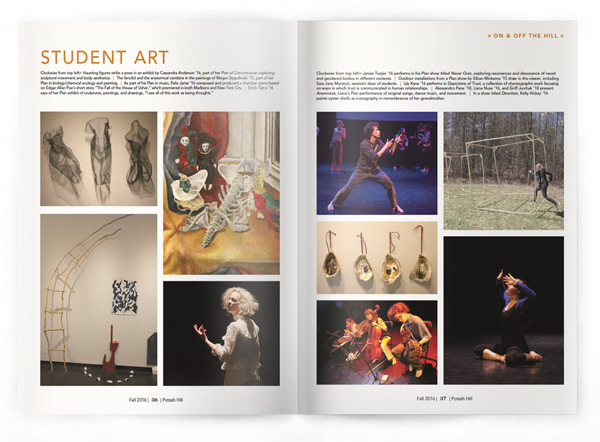
Left Page. clockwise from top left> Haunting figures strike a pose in an exhibit by Cassandra Anderson ’16, part of her Plan of Concentration exploring sculptural movement and body aesthetics. | The fanciful and the anatomical combine in the paintings of Megan Stypulkoski ’15, part of her Plan in biology/chemical ecology and painting. | As part of his Plan in music, Felix Jarrar ’16 composed and produced a chamber opera based on Edgar Allan Poe’s short story “The Fall of the House of Usher,” which premiered in both Marlboro and New York City. | Emily Tatro ’16 says of her Plan exhibit of sculptures, paintings, and drawings, “I see all of this work as being thoughts.”
Right page, clockwise from top left> James Turpin ’16 performs in his Plan show titled Never Over, exploring resonances and dissonance of raced and gendered bodies in different contexts. | Outdoor installations from a Plan show by Ethan Minkema ’15 draw in the viewer, including Sara Jane Muratori, assistant dean of students. | Lily Kane ’16 performs in Depictions of Trust, a collection of choreographic work focusing on ways in which trust is communicated in human relationships. | Alessandro Pane ’18, Liana Nuse ’16, and Griff Jurchak ‘18 present Anamnesis, Liana’s Plan performance of original songs, dance music, and movement. | In a show titled Devotion, Kelly Hickey ’16 paints oyster shells as iconography in remembrance of her grandmother.
Commencement 2016
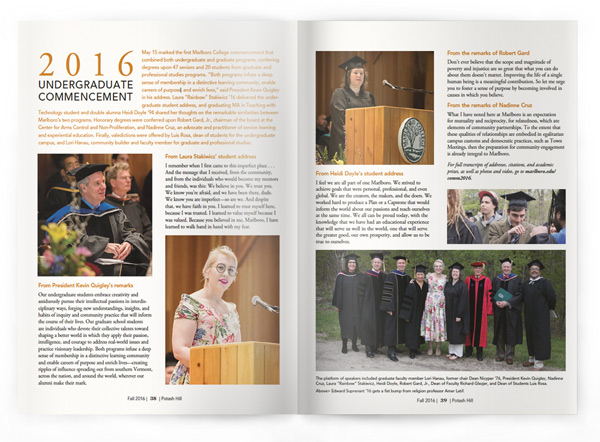
May 15 marked the first Marlboro College commencement that combined both undergraduate and graduate programs, conferring degrees upon 47 seniors and 20 students from graduate and professional studies programs. “Both programs infuse a deep sense of membership in a distinctive learning community, enable careers of purpose, and enrich lives,” said President Kevin Quigley in his address. Laura “Rainbow” Stakiwicz ’16 delivered the undergraduate student address, and graduating MA in Teaching with Technology student and double alumna Heidi Doyle ’94 shared her thoughts on the remarkable similarities between Marlboro’s two programs. Honorary degrees were conferred upon Robert Gard, Jr., chairman of the board at the Center for Arms Control and Non-Proliferation, and Nadinne Cruz, an advocate and practitioner of service learning and experiential education. Finally, valedictions were offered by Luis Rosa, dean of students for the undergraduate campus, and Lori Hanau, community builder and faculty member for graduate and professional studies.
From President Kevin Quigley’s remarks
Our undergraduate students embrace creativity and assiduously pursue their intellectual passions in interdisciplinary ways, forging new understandings, insights, and habits of inquiry and community practice that will inform the course of their lives. Our graduate school students are individuals who devote their collective talents toward shaping a better world in which they apply their passion, intelligence, and courage to address real-world issues and practice visionary leadership. Both programs infuse a deep sense of membership in a distinctive learning community and enable careers of purpose and enrich lives—creating ripples of influence spreading out from southern Vermont, across the nation, and around the world, wherever our alumni make their mark.
From Laura Stakiwicz’ student addressI remember when I first came to this imperfect place . . . And the message that I received, from the community, and from the individuals who would become my mentors and friends, was this: We believe in you. We trust you. We know you’re afraid, and we have been there, dude. We know you are imperfect—so are we. And despite that, we have faith in you. I learned to trust myself here, because I was trusted. I learned to value myself because I was valued. Because you believed in me, Marlboro, I have learned to walk hand in hand with my fear.
From Heidi Doyle’s student address
I feel we are all part of one Marlboro. We strived to achieve goals that were personal, professional, and even global. We are the creators, the makers, and the doers. We worked hard to produce a Plan or a Capstone that would inform the world about our passions and teach ourselves at the same time. We all can be proud today, with the knowledge that we have had an educational experience that will serve us well in the world, one that will serve the greater good, our own prosperity, and allow us to be true to ourselves.
From the remarks of Robert Gard
Don’t ever believe that the scope and magnitude of poverty and injustice are so great that what you can do about them doesn’t matter. Improving the life of a single human being is a meaningful contribution. So let me urge you to foster a sense of purpose by becoming involved in causes in which you believe.
From the remarks of Nadinne Cruz
What I have noted here at Marlboro is an expectation for mutuality and reciprocity, for relatedness, which are elements of community partnerships. To the extent that these qualities of relationships are embodied in egalitarian campus customs and democratic practices, such as Town Meetings, then the preparation for community engagement is already integral to Marlboro.
For full transcripts of addresses, citations, and academic prizes, as well as photos and video, go to marlboro.edu/comm2016.
Alumni News
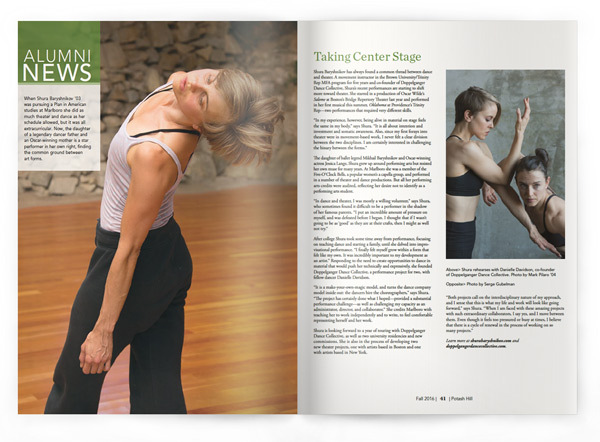
Taking Center Stage
When Shura Baryshnikov ’03 was pursuing a Plan in American studies at Marlboro she did as much theater and dance as her schedule allowed, but it was all extracurricular. Now, the daughter of a legendary dancer father and an Oscar-winning mother is a star performer in her own right, finding the common ground between art forms.
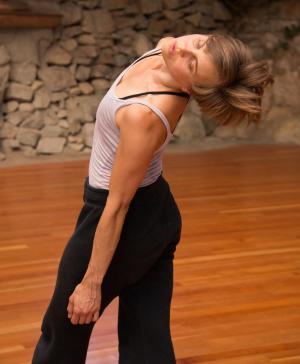 Shura Baryshnikov has always found a common thread between dance and theater. A movement instructor in the Brown University/Trinity Rep MFA program for five years and co-founder of Doppelganger Dance Collective, Shura’s recent performances are starting to shift more toward theater. She starred in a production of Oscar Wilde’s Salome at Boston’s Bridge Repertory Theater last year and performed in her first musical this summer, Oklahoma at Providence’s Trinity Rep—two performances that required very different skills.
Shura Baryshnikov has always found a common thread between dance and theater. A movement instructor in the Brown University/Trinity Rep MFA program for five years and co-founder of Doppelganger Dance Collective, Shura’s recent performances are starting to shift more toward theater. She starred in a production of Oscar Wilde’s Salome at Boston’s Bridge Repertory Theater last year and performed in her first musical this summer, Oklahoma at Providence’s Trinity Rep—two performances that required very different skills.
“In my experience, however, being alive in material on stage feels the same in my body,” says Shura. “It is all about intention and investment and somatic awareness. Also, since my first forays into theater were in movement-based work, I never felt a clear division between the two disciplines. I am certainly interested in challenging the binary between the forms.”
The daughter of ballet legend Mikhail Baryshnikov and Oscar-winning actress Jessica Lange, Shura grew up around performing arts but resisted her own muse for many years. At Marlboro she was a member of the Five-O’Clock Bells, a popular women’s a capella group, and performed in a number of theater and dance productions. But all her performing arts credits were audited, reflecting her desire not to identify as a performing arts student.
“In dance and theater, I was mostly a willing volunteer,” says Shura, who sometimes found it difficult to be a performer in the shadow of her famous parents. “I put an incredible amount of pressure on myself, and was defeated before I began. I thought that if I wasn’t going to be as ‘good’ as they are at their crafts, then I might as well not try.”
 After college Shura took some time away from performance, focusing on teaching dance and starting a family, until she delved into improvisational performance. “I finally felt myself grow within a form that felt like my own. It was incredibly important to my development as an artist.” Responding to the need to create opportunities to dance in material that would push her technically and expressively, she founded Doppelganger Dance Collective, a performance project for two, with fellow dancer Danielle Davidson.
After college Shura took some time away from performance, focusing on teaching dance and starting a family, until she delved into improvisational performance. “I finally felt myself grow within a form that felt like my own. It was incredibly important to my development as an artist.” Responding to the need to create opportunities to dance in material that would push her technically and expressively, she founded Doppelganger Dance Collective, a performance project for two, with fellow dancer Danielle Davidson.
“It is a make-your-own-magic model, and turns the dance company model inside out: the dancers hire the choreographers,” says Shura. “The project has certainly done what I hoped—provided a substantial performance challenge—as well as challenging my capacity as an administrator, director, and collaborator.” She credits Marlboro with teaching her to work independently and to write, to feel comfortable representing herself and her work.
Shura is looking forward to a year of touring with Doppelganger Dance Collective, as well as two university residencies and new commissions. She is also in the process of developing two new theater projects, one with artists based in Boston and one with artists based in New York.
“Both projects call on the interdisciplinary nature of my approach, and I sense that this is what my life and work will look like going forward,” says Shura. “When I am faced with these amazing projects with such extraordinary collaborators, I say yes, and I move between them. Even though it feels too pressured or busy at times, I believe that there is a cycle of renewal in the process of working on so many projects.”
Learn more at shurabaryshnikov.com and doppelgangerdancecollective.com.
Class Notes
Class notes are listed by year and include both graduates and nongraduates; the latter are listed under the class with which they are associated.
’66
“Whatever zip code I lived in, I was very clear where my home was and I was clear I would be coming back,” says JACK RUSSELL in a recent post on “Acadia on My Mind,” part of the BDN Maine Network. After many years working in government and nonprofits in Michigan, Jack returned 10 years ago to the home where he was raised on Mount Desert Island, Maine. Now he is co-chair of the Acadia Centennial Task Force, which is organizing the celebration of Acadia National Park’s 100th anniversary this year. “The park is central in our lives and in our community,” says Jack. Learn more.
’67
“About to start writing a new book,” says ARTHUR MAGIDA. “Details to follow.”
’70 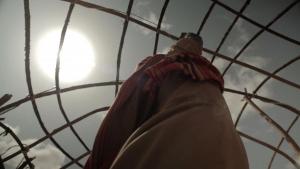 “Still in my house in New Orleans, retired from the restaurant business,” says MARGARET MARX. “Recently visited with or by RICK NICKERSON, GILBERT PALLEY, FREDDY BARRETT, JEFFREY TURNER, PARNEE HALL, and LYNN MANDEL. The unusual thing is that we all seem to still like one another.”
“Still in my house in New Orleans, retired from the restaurant business,” says MARGARET MARX. “Recently visited with or by RICK NICKERSON, GILBERT PALLEY, FREDDY BARRETT, JEFFREY TURNER, PARNEE HALL, and LYNN MANDEL. The unusual thing is that we all seem to still like one another.”
’71
FREDERICK GRAY says, “Had two wonderful visits in January and October of 2015 with Tom Tucker and his fabulous wife, Laura Frizzell, and their extended family in Portland, Oregon. My granddaughter Tallulah is raising and showing goats in the Oakland, California, Hills.
’76
“I live in a Victorian-style duplex in Oakland with a view of San Francisco from my kitchen table,” says WANDA RAVERNELL. “I spend most of my time with activities around the nonprofit I started, called Omnira Institute. Its mission is to revive and reinvigorate African and African American cultural practices that can contribute to the mental and spiritual health of people of African descent. Our work involves presentations by Awon Ohun Omnira (Voices of Freedom), a small chorus that includes three Bata drummers and four or five vocalists, including me, of all people. We sing praise songs for the ancestors in old Yoruba and attempt to represent the Ring Shout, a tradition developed by the Africans enslaved in the southeastern U.S. We put on several events a year, including the Black-Eyed Pea Festival in September.”
’77
After being complimented on her warm and warbling voice many times over the years, former receptionist SUNNY TAPPAN decided to do something about it and become trained as a voice actor. “To make a long story short, I went for the intro session thinking it would be a cheap evening’s entertainment and then became so intrigued with what I learned that I signed up for the training, starting with a speech pathology session in the studio to see if I was capable of voice acting. I have now completed my training plus a short demo, which is my voice-acting resume. You can listen to it at SunnyTappan.icanvoice.com. My next challenge is to market myself for things like books on tape, audio guides, answering messages for business phone systems, public service announcements, radio ads, or anything else that my voice might be suitable for."
’78
I’m retiring from Daito Bunka University, Tokyo, Japan, after 45 years’ teaching,” says TSUTOMU TANAKA. “Best wishes to my Marlboro friends.”
“It’s a small Marlboro world,” writes LINDA KAUFMAN. “PAMELA CONTAKOS ’98 (nee Clarke) and I are both librarians at Massachusetts College of Liberal Arts, in North Adams.”
’80 JOANNE AYOUB says, “This year, I will celebrate 30 years at Beth Israel Deaconess Medical Center in Boston. How is this possible? I still see myself sitting on Marlboro’s hill, looking out to the colors of fall. My work in health care has taken me to some far away places, throughout Turkey and the Mideast, for the past 15 years. And wherever I go, there’s a Marlboro connection to be found. Hello to my dear Marlboro friends. Hey, Toleno :).”
“Still a media critic,” says STEVEN SMITH. “Still living in Wilmington, Delaware, but moving soon to a farmhouse in Pennsylvania. I program and host dozens of conferences and retreats in the U.S. and Europe for media and marketing executives on the future of both in the digital age. Currently revisiting much of the RLP seminar syllabus and mountain of novels I read for Audrey, Geri, and Dick—now that I may be old enough to appreciate them.”
“I love working with my hands, and I really love animals,” says MEGAN LITTLEHALES in a recent article in The Commons featuring her new practice, offering therapeutic massage and Reiki to dogs. Under the name Lady Moon Healing Hands, Megan has performed Reiki on horses, sheep, chickens, a mountain lion in a wildlife rescue preserve, and a ball python with an upper respiratory infection. Learn more.
’85
MONIKA MACLEAN says, “Back in school at UConn graduate school of nursing, in the adult gerontology nurse practitioner primary care program. This will be degree #4. Volunteering at the Hartford Gay and Lesbian Health Collective, and hoping to be going into LGBT-friendly primary care when I graduate.”
’86
SANDRA RUDD says, “For the past seven years I have been, and for the foreseeable future will continue to be, the pastor of Sitka Lutheran Church. Any alumni coming through Southeast Alaska on your travels, please stop by.” Reminiscing on her Marlboro experience, Sandra asks: “When will the Rice (library) and Brown (science) buildings be connected to become the Brown-Rice Complex? :-)”
’88
PETER COLTON MADDEN writes, “After working for Plum Creek Timber Company for 23 years, I decided to go help one of their largest customers—Drax Biomass—and reduce Europe’s coal dependence.”
’89
In February, VAUNE TRACHTMAN had an exhibit of her recent work at the Southern Vermont Arts Center, in Manchester, Vermont, titled “Out of Range: Cellphone Photography by Vaune Trachtman.” “The photographs are evocative, much in the way the first consciously photographic artists, the Pictorialists, used soft focus to leave space for the viewer to look for associations,” said the Valley News.
Stamping Out Pain: Ithiel Fuller ’95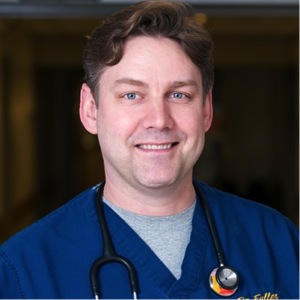 When alumnus Norman Paradis ’79 visited Marlboro in the 1990s to give a talk on his research in emergency medicine, Ithiel Fuller was considering medicine as one of many career choices. But he was not sure how to proceed until Norm took him under his wing.
When alumnus Norman Paradis ’79 visited Marlboro in the 1990s to give a talk on his research in emergency medicine, Ithiel Fuller was considering medicine as one of many career choices. But he was not sure how to proceed until Norm took him under his wing.
“Norm was a very entertaining speaker,” says Ithiel, now a partner at Anesthesia Physicians of Brattleboro. “While a discussion of medical research methods might seem to be a rather dry topic, his talk was full of juicy descriptions of things such as using small balloons inside the body to enhance CPR.”
Biology professor Bob Engel gave Ithiel a personal introduction to Norm, specifically to encourage the young student to visit Norm’s medical research laboratory at Columbia University. But the visit turned into a job interview, which turned into a position as a research technician.
“I enjoyed the work immensely, and continued working in research labs for six years until I remembered that I still wanted to go to medical school. By that time I had co-authored multiple publications, which lent great strength to my application.” Ithiel graduated from the Medical College of Virginia in 2005, and started working in Brattleboro four years later.
“Every day I get to directly help other human beings, which is very gratifying,” says Ithiel, who returned to Marlboro himself last April to give a talk on pursuing medical professions. “I stamp out pain wherever I find it, but the art of my specialty lies in preventing pain from ever happening in the first place.”
’90
“I love the artists we work with, and I am so proud when they send their projects out to the community,” says Vermont Performance Lab founder SARA COFFEY. In June she hosted Jane Chu, National Endowment for the Arts chairman, who was touring arts facilities in southern Vermont. Learn more.
’91
In March, AMELIA DARROW joined the law firm of Corum, Mabie, Cook, Prodan, Angell, and Secrest of Brattleboro as an associate attorney. According to an article in The Commons, Amelia works with individuals and businesses practicing corporate law, employment law, business and estate planning, and family law. She received her Juris Doctor from Vermont Law School, cum laude, in 2015.
’92
In May, PETER BLANCHETTE debuted a new CD with the Happy Valley Guitar Orchestra at a concert in Northampton. Titled Unknown Album, the CD features recent repertoire ranging from Beethoven Symphony No. 7’s iconic Allegretto movement to popular Midwest rockers Wilco, minimalist composer Philip Glass, and South American composer Gustavo Santaolalla. “I named it Unknown Album because this is music that’s never been heard before,” says Peter. “Beethoven’s 7th certainly wasn’t conceived for electric guitars, 16th-century French dances didn’t have backbeats, and Wilco’s One Wing wasn’t originally arranged with as much counterpoint as a Beethoven symphony. HVGO’s process—where I arrange music for all these guitars, and the musicians lend their particular guitar sound to the piece—is always an exploration of great music.”
LAURA FRANK received a Live Design award in June, in recognition of her technical excellence in media technology for television, special events, theater, concerts, film, and corporate. “Laura has technical qualifications, to be sure,” said Soren West, CEO of Atomic Design. “By combining her extraordinary intellect and curiosity with chutzpah, she has positioned herself on the cutting edge of our industry.” Learn more.
“One of the things that Randy took away from his time baking at Marlboro College was his passion for naturally leavened breads,” says a cover article about RANDY GEORGE in the publication of the Brattleboro Food Co-op, Food for Thought. Randy’s Red Hen Bakery (Potash Hill, Fall 2015) was “producer of the month” for April at the co-op, where the daily arrival of his breads are eagerly anticipated.
’93
“One of the most compelling things to hear on the radio is two people interacting,” says SEAN COLE, producer at National Public Radio’s This American Life. “We forget we [the interviewers] are people too.” In an interview about interviewing, on CBC Radio, Sean explains how to “make good tape,” develop a split brain, and adjust to reality. Read more and see Sean in action.
’95 “We’ve got a sort of perfect storm here: high unemployment, high drug use, a lot of poverty. So, we wind up with kids who are an inadvertent result of that,” says PIPPA AREND in an article in Portland Monthly. Titled “Why Oregon Women Need Radical Reform at Home and On the Job,” the article is a conversation between Pippa, co-founder of a mentoring organization for homeless youth called p:ear, and Andrea Paluso of Family Forward Oregon. Together they discuss self-sacrifice, the value of caregiving, and the decision to have children (or not). Learn more.
In March, MARK LAMOUREUX gave a talk on women poets who also run small publishing presses, part of the Women of Wisdom faculty lecture series at Housatonic Community College, where he is a lecturer in English.
’96
“Hello beautiful people. I am still in Los Angeles, working on the TNT show The Last Ship as assistant editor,” says ERIN PETERS. “I see LAURA DERBY ’98 often, and she is great, working for Tree People, a nonprofit environmental organization. Thinking of maple syrup and fall on Hogback Mountain as I lounge on the beach in January. ;-P ”
’97
WENDY LEVY reports, “I recently learned I won the ‘Rookie-of-the-Year’ Award from the New England Newspaper and Press Association. On February 19, at the yearly convention, I’ll have to go onstage to receive my plaque. I’m excited, but very nervous. The last time I had to go on stage to receive anything was in 1997, when I graduated from Marlboro. Also, my story on the recent changes in the FDA’s raw-milk cheese standards got ‘tweeted’ by Representative Peter Welch (VT-AL). He characterized it as a ‘good read.’” Read it online.
“I began to understand that we have at least four overlapping criminal archetypes, and that they combine to create a cultural narrative in which white criminals are offered a path to redemption, and criminals of color are dehumanized,” says DENI BÉCHARD. Drawing from his personal experiences, observations, and national statistics, Deni gave a talk titled “Race and the Myth of the American Outlaw” as part of a TEDxNapaValley event in April. Learn more.
’03
RACHEL JENSEN was one of three emerging artists awarded an Astoria Visual Arts residency, which provided her with a rent-free studio in Astoria, Oregon, from April through June. Born and raised in Astoria, Rachel’s recent paintings explore color and texture through the building-up of layers that are later removed to expose what is underneath. Learn more.
’04
“I moved to Brooklyn in late September,” says HEATHER BRYCE LABOR. “Since my move I’ve held auditions for Bryce Dance Company and now have a professional company of nine dancers. We have performances booked through the end of the year and more to follow. Check out the website for more information at brycedancecompany.com—we’re currently celebrating our 10th anniversary. I’ve also started working for Alvin Ailey American Dance Theater in two roles: AileyCamp alumni coordinator and as a teaching artist. I currently have four residencies in Queens and Manhattan. Life is good.”
Utility Matters: Aaron Kisicki ’02 “The transition from Marlboro to law school was a little bumpy,” says attorney Aaron Kisicki. “It was like I was back in high school: a professor at the front of the room highlighting the salient points of the reading. It wasn’t engaging. I would want to discuss an issue further, but the professor would simply say that there was nothing more to discuss and move on.”
“The transition from Marlboro to law school was a little bumpy,” says attorney Aaron Kisicki. “It was like I was back in high school: a professor at the front of the room highlighting the salient points of the reading. It wasn’t engaging. I would want to discuss an issue further, but the professor would simply say that there was nothing more to discuss and move on.”
Aaron reflects differently on his time at Marlboro, where he worked with Meg Mott and John Sheehy to develop a Plan of Concentration focused on constitutional law and the then-newly-passed U.S.A. Patriot Act. Now an attorney with the Vermont Department of Public Service representing the public interest in state utility proceedings, Aaron still looks back on his Marlboro years as crucial to developing his skills as a lawyer.
“The internet was in its infancy when I was at Marlboro,” says Aaron. “Now students have the ability to quickly access online information at will. The old model of a professor standing at the head of a room and acting as a fountain of knowledge doesn’t work well today. Developing skill sets that allow one to understand, synthesize, and articulate information is now more important than ever. Marlboro has always focused on building those skills, and it does so in a way that no other school can.”
’11
NICK LEGOWSKI is living in Brooklyn, working as the self-advocacy advisor for AHRC New York City and working on a master’s degree in urban planning at Hunter College.
SARI BROWN received a Master of Divinity from Candler School of Theology at Emory University in Atlanta in 2014. “During my seminary studies, I worked with a Latino/a congregation in the greater Atlanta area, as well as doing a semester abroad at the Universidade Metodista in São Paulo, Brazil, and a summer internship with a Methodist congregation in Medellín, Colombia. I also spent a Christmas season in La Paz, Bolivia, where I had carried out ethnographic research for my Plan in 2010, to finally bring back a Spanish version of my Plan work to share with the people of the Bolivian Methodist Church, who were so key in helping me elaborate it. Along the way I met Ricardo Angarita, a Colombian Methodist pastor, social worker, community organizer, and insatiable enjoyer of life who is now my husband. Our marriage has also brought three wonderful stepchildren into my life: Mayerly (24), Lesly (20), and Richard (10). In March of 2016, I was approved to be commissioned as a provisional elder (i.e., pastor) in the United Methodist Church, and in July I began my first appointment as associate pastor of Grosse Pointe United Methodist Church in the Detroit, Michigan, area. I am still waiting for Ricardo, Lesly, and Richard to join me here in Michigan—the visa process is a beast. In the meantime, when I got back to the States I took a wonderful trip out east to visit friends and family, including my Marlboro family. I greatly enjoyed catching up with my professors and dear friends Amer Latif, Carol Hendrickson, and William Edelglass and their respective spouses, as well as getting to meet their children—both human and, in Carol’s case, canine. I also enjoyed meeting anthropology professor Nelly Sargsyan and her family, and sitting at Sunny’s desk to chat with her like old times. In Northampton I caught up with TOBEY LAROCHE ’10, and in NYC I saw MICHAEL MIRER as well as AMBER SCHAEFER ’10, which was a complete surprise since I had no idea she was dating my cousin. I continue to carry my experience at Marlboro in my mind and heart, and feel deeply grateful for how it has shaped me. I burst into tears of gratitude and nostalgia when I went to the library and found my Plan on the shelf.”
’12 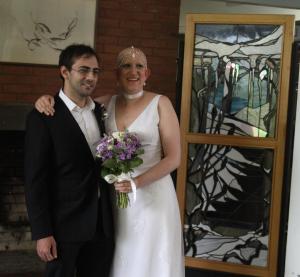 In Fall 2014, MERCEDES LAKE started Northwestern University’s MFA program in writing for the screen and stage. Her plays have been performed at the Chicago Dramatists, MasterClash, and as part of Scrap Mettle Art’s Emerging Playwrights Program. Mercedes has also worked for the site-specific theater company Living Room Playmakers. At Northwestern, Mercedes was a finalist for the Northwestern University Sitcom Grant, through which she was flown to LA to meet Julia Louis Dreyfus. Mercedes is pleased to announce that her original play Taught will be premiering in New York City this October in partnership with the Araca Foundation. She currently lives in Chicago with her boyfriend and cat, Fluffy Muffin.
In Fall 2014, MERCEDES LAKE started Northwestern University’s MFA program in writing for the screen and stage. Her plays have been performed at the Chicago Dramatists, MasterClash, and as part of Scrap Mettle Art’s Emerging Playwrights Program. Mercedes has also worked for the site-specific theater company Living Room Playmakers. At Northwestern, Mercedes was a finalist for the Northwestern University Sitcom Grant, through which she was flown to LA to meet Julia Louis Dreyfus. Mercedes is pleased to announce that her original play Taught will be premiering in New York City this October in partnership with the Araca Foundation. She currently lives in Chicago with her boyfriend and cat, Fluffy Muffin.
’13
“Lots of exciting things happening on my end,” says EVAN LORENZEN. “This last May, one of my miniature books was selected to be part of an exhibition at the Central Cultural Bank of Brazil in Rio de Janeiro. Currently, I have two shows up in Denver: one consists of tiny art and altarpieces based off of the zodiac calendar, while the other (opening in February) is composed of florally inspired watercolors and ceramics. Besides that, just continuing to consistently work on miniature art and collaborations. If you happen to be in Denver, feel free to come visit me at Indyink where I work as a graphic designer.”
’15
After graduating with an MBA from Clarkson University, AMELIA BROWN says she wants to “work in communications, marketing, or strategy of international NGOs working towards global change, preferably with a focus on the Middle East. I’m interviewing with a couple of places, but my current plan is moving to NYC next month and networking with organizations and Marlboro and Clarkson alums.”
ERIKA KLEMPERER worked with the Brattleboro School of Dance as a guest choreographer, co-choreographing a piece with Jamie Gehring for the spring dance concert in May titled “For You…With Love.”
Graduate and Professional Studies
Management
’12
JOHN TEDESCO MBA (see Potash Hill, Spring 2015) was one of six Marlboro alumni taking part in a panel discussion and workshop on Local + Social Enterprise in February, co-sponsored by Marlboro College and Vermont Businesses for Social Responsibility. Also included were STACY METZGER MBA ’15, ALEX FISCHER MBA ’14, NOAH FISHMAN MBA ’15, KEVIN LEHMAN MBA ‘11, and ELIZABETH GLENSHAW ’81. The workshop examined businesses that place a social mission ahead of or on par with their financial mission, and explored the role of business in making social change and achieving sustainability.
’14
“Being a part of the Women’s Leadership Circle via my Capstone, as a consultant, and most recently as a participant, has been incredibly empowering,” says JANE NESBITT MSM. “I am thrilled and honored to contribute to its future.”
Building on her graduate work, SOPHIE ABRAMS MBA was hired to lead a yearlong study on the management of commercial food waste on Martha’s Vineyard, in preparation for a state ban on food waste. Sophie conducted a feasibility study for Island Grown Initiative while at Marlboro College, and this more comprehensive study is designed to bring an island-wide approach to food waste within reach. For an island community, Sophie said, “being as self-sufficient as we can in the future is really important. I think food is a small part of that.” Learn more at goo.gl/BL4ecY.
Teaching
’12
“After my studies at Marlboro I was granted a Rowland sabbatical that let me travel the world looking at innovation in education,” says ADAM PROVOST MAT, president of VITA-Learn. “I was then offered a hybrid position at Burlington School District as a technology integration specialist, which included a role as an innovator with their Nellie Mae Partnership for Change grant. I’m now working in the job I wanted, with a great team. The new knowledge and colleagues that became part of my life while at Marlboro are a valuable part of my renewed career today. Innovating again . . . and loving it.”
Former Faculty and Staff
“I recently spent a month with the Heath Quartet at Middlebury College,” says retired sociology professor JERRY LEVY. “Am embarking on a West Coast tour of my play, The Third Coming: Marx Returns.”
In his latest book, Fluke: The Math and Myth of Coincidence (Basic Books 2016, ISBN #9780465060955), retired math professor JOSEPH MAZUR offers us proof of the inevitability of the sublime and the unexpected. Joe’s book succinctly tackles the math behind phenomena of chance and happenstance, from dreams that come true to the risk in financial markets. The Wall Street Journal says, “Always entertaining and frequently insightful, Fluke is never less than thought-provoking.” Learn more about it in a VPR interview from April.
In February, retired biology professor BOB ENGEL gave an illustrated lecture titled “The Birds in Your Woods: How You Can Help Them,” at the Vermont Learning Collaborative in Dummerston, Vermont. Sponsored by the Windham Regional Woodlands Association and the Southeastern Vermont Audubon Society, the presentation centered on the welfare of ground-nesting and other forest-dependent birds. Bob discussed the important role that woodland birds play in the ecosystem, and management approaches to help restore and maintain local woodlands for these birds.
In Memoriam
David Tyler, former student ’51
A student of Marlboro College in its very earliest years, David Tyler of Benson, Vermont, died in March 2016 following a long illness. David was born in Rochester, New York, and grew up in Plainfield, New Jersey. He graduated from the Putney School, in Putney, Vermont, then went on to Marlboro in 1947. After leaving Marlboro he purchased a 500-acre farm in Worthington, Massachusetts, where he raised registered Polled Herefords and hay. He was the head selectman, chief of police, tree warden, and animal control officer in Worthington for many years. David married Debra Lord in 1976, and they relocated to Benson, Vermont, where they established Tylord Farm, raising beef cattle, hay, and Trakehner horses. He enjoyed hunting, fishing, and photography. David is survived by his wife, Debra, two children, and two grandchildren.
Garby Leon ’69
An executive at 20th Century Fox, Garby Leon died in April 2014 after a long battle with cancer. Born in New York City, after graduating from Marlboro with a Plan in music he went on to earn a PhD in music from Harvard University. He was a conscientious objector during the Vietnam War and active in the antiwar movement. Garby held many positions in the movie industry, including vice president of production at Dan Curtis Productions and Fox Family Films, story analyst at Columbia Pictures and Lorimar, and director of development at Silver Pictures, where he worked on The Matrix and The Manchurian Candidate. He had been a story analyst at Fox since the mid 2000s, and was active in the Motion Picture Editors Guild. Garby was the son of Fernando Leon, an active Marlboro trustee in the 1970s, who died in 2009, and brother of Rod Leon ’73. He is survived by his wife, Shannon Mow, and a daughter.
Hiroharu Watanabe ’82 Hiroharu “Hiro” Watanabe died in New York City in August 2016, after a brief illness. Born in Kumamoto City, Japan, in 1956, Hiro attended high school in Japan, Australia, and at the American Language Academy at Northfield Mount Hermon, in Massachusetts, before coming to Marlboro College. He learned about Marlboro from John Tohr Yamaguchi, who was a former student and taught in Australia at the University of South Wales. Hiro’s Plan of Concentration at Marlboro College was in visual arts and art history, focusing on the painting and sculpture of the pop movement of the 1960s and 70s. His classmates remember him for his infectious smile and his inclination to photograph absolutely everything. Hiro is survived by his mother, Sachiko Watanabe, of Japan and his sister Kazuko Uematsu, her sons Gotaro and Ryuji, and their children, all of Sydney, Australia. He is also survived by many friends in America, several of whom considered him a member of their own families.
Hiroharu “Hiro” Watanabe died in New York City in August 2016, after a brief illness. Born in Kumamoto City, Japan, in 1956, Hiro attended high school in Japan, Australia, and at the American Language Academy at Northfield Mount Hermon, in Massachusetts, before coming to Marlboro College. He learned about Marlboro from John Tohr Yamaguchi, who was a former student and taught in Australia at the University of South Wales. Hiro’s Plan of Concentration at Marlboro College was in visual arts and art history, focusing on the painting and sculpture of the pop movement of the 1960s and 70s. His classmates remember him for his infectious smile and his inclination to photograph absolutely everything. Hiro is survived by his mother, Sachiko Watanabe, of Japan and his sister Kazuko Uematsu, her sons Gotaro and Ryuji, and their children, all of Sydney, Australia. He is also survived by many friends in America, several of whom considered him a member of their own families.
Magnanimity Cum Laude
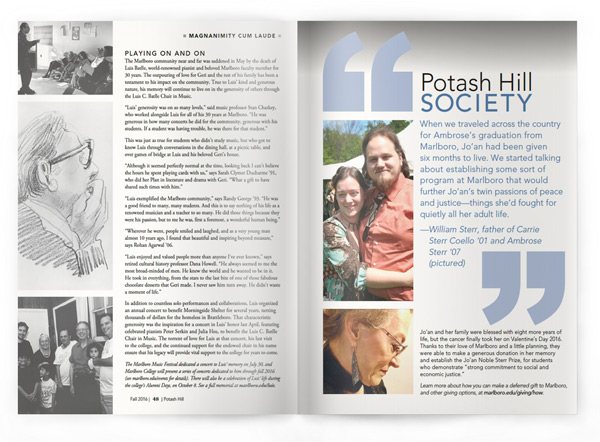
Playing On and On
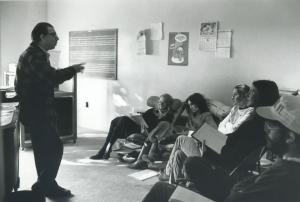 The Marlboro community near and far was saddened in May by the death of Luis Batlle, world-renowned pianist and beloved Marlboro faculty member for 30 years. The outpouring of love for Geri and the rest of his family has been a testament to his impact on the community. True to Luis’ kind and generous nature, his memory will continue to live on in the generosity of others through the Luis C. Batlle Chair in Music.
The Marlboro community near and far was saddened in May by the death of Luis Batlle, world-renowned pianist and beloved Marlboro faculty member for 30 years. The outpouring of love for Geri and the rest of his family has been a testament to his impact on the community. True to Luis’ kind and generous nature, his memory will continue to live on in the generosity of others through the Luis C. Batlle Chair in Music.
“Luis’ generosity was on so many levels,” said music professor Stan Charkey, who worked alongside Luis for all of his 30 years at Marlboro. “He was generous in how many concerts he did for the community, generous with his students. If a student was having trouble, he was there for that student.”
This was just as true for students who didn’t study music, but who got to know Luis through conversations in the dining hall, at a picnic table, and over games of bridge at Luis and his beloved Geri’s house. “Although it seemed perfectly normal at the time, looking back I can’t believe the hours he spent playing cards with us,” says Sarah Clymer Ducharme ’91, who did her Plan in literature and drama with Geri. “What a gift to have shared such times with him.”
“Luis exemplified the Marlboro community,” says Randy George ’93. “He was a good friend to many, many students. And this is to say nothing of his life as a renowned musician and a teacher to so many. He did those things because they were his passion, but to me he was, first a foremost, a wonderful human being.”
“Wherever he went, people smiled and laughed, and as a very young man almost 10 years ago, I found that beautiful and inspiring beyond measure,” says Rohan Agarwal ’06.
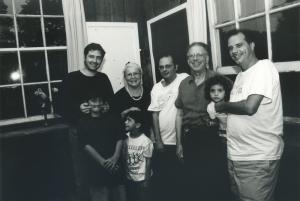 “Luis enjoyed and valued people more than anyone I’ve ever known,” says retired cultural history professor Dana Howell. “He always seemed to me the most broad-minded of men. He knew the world and he wanted to be in it. He took in everything, from the stars to the last bite of one of those fabulous chocolate desserts that Geri made. I never saw him turn away. He didn’t waste a moment of life.”
“Luis enjoyed and valued people more than anyone I’ve ever known,” says retired cultural history professor Dana Howell. “He always seemed to me the most broad-minded of men. He knew the world and he wanted to be in it. He took in everything, from the stars to the last bite of one of those fabulous chocolate desserts that Geri made. I never saw him turn away. He didn’t waste a moment of life.”
In addition to countless solo performances and collaborations, Luis organized an annual concert to benefit Morningside Shelter for several years, netting thousands of dollars for the homeless in Brattleboro. That characteristic generosity was the inspiration for a concert in Luis’ honor last April, featuring celebrated pianists Peter Serkin and Julia Hsu, to benefit the Luis C. Batlle Chair in Music. The torrent of love for Luis at that concert, his last visit to the college, and the continued support for the endowed chair in his name ensure that his legacy will provide vital support to the college for years to come.
The Marlboro Music Festival dedicated a concert to Luis’ memory on July 30, and Marlboro College will present a series of concerts dedicated to him through fall 2016 (see marlboro.edu/events for details). There will also be a celebration of Luis’ life during the college’s Alumni Days, on October 8. See a full memorial.
Potash Hill Society
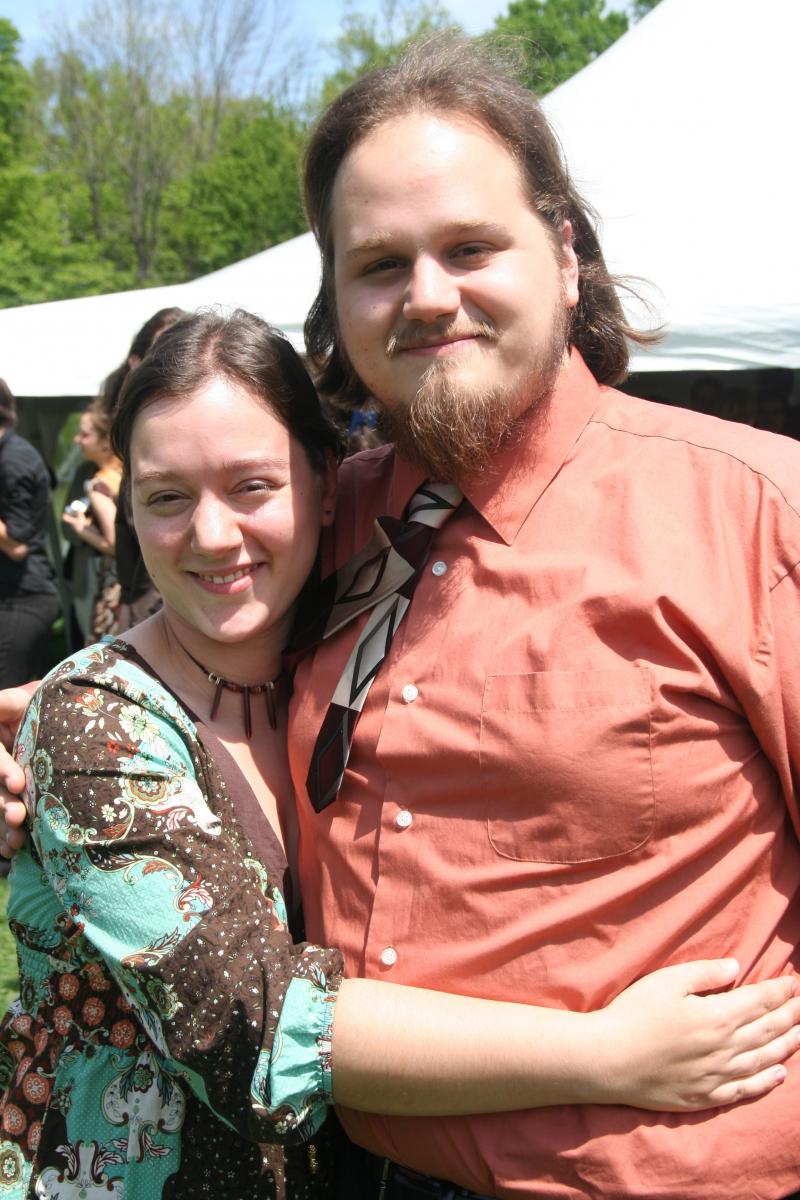 “When we traveled across the country for Ambrose’s graduation from Marlboro, Jo’an had been given six months to live. We started talking about establishing some sort of program at Marlboro that would further Jo’an’s twin passions of peace and justice—things she’d fought for quietly all her adult life.”
“When we traveled across the country for Ambrose’s graduation from Marlboro, Jo’an had been given six months to live. We started talking about establishing some sort of program at Marlboro that would further Jo’an’s twin passions of peace and justice—things she’d fought for quietly all her adult life.”
—William Sterr, father of Carrie Sterr Coello ’01 and Ambrose Sterr ’07 (pictured, right)
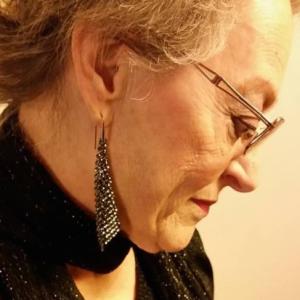 Jo’an and her family were blessed with eight more years of life, but the cancer finally took her on Valentine’s Day 2016. Thanks to their love of Marlboro and a little planning, they were able to make a generous donation in her memory and establish the Jo’an Noble Sterr Prize, for students who demonstrate “strong commitment to social and economic justice.” Learn more about how you can make a deferred gift to Marlboro, and other giving options.
Jo’an and her family were blessed with eight more years of life, but the cancer finally took her on Valentine’s Day 2016. Thanks to their love of Marlboro and a little planning, they were able to make a generous donation in her memory and establish the Jo’an Noble Sterr Prize, for students who demonstrate “strong commitment to social and economic justice.” Learn more about how you can make a deferred gift to Marlboro, and other giving options.
Special Web Features
Rooted in the basics: An interview with Jenny Ramstetter
Sophomore Noah Strauss Jenkins sat down with biology and environmental studies professor Jenny Ramstetter last February to discuss climate change, statistics, forest reserves, and the Afromontane vegetation of Ethiopia.
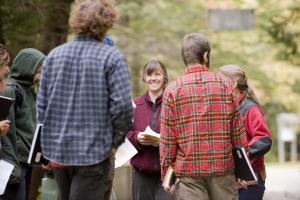 Noah Strauss Jenkins: So how do you like the snow?
Noah Strauss Jenkins: So how do you like the snow?
Jenny Ramstetter: Love, love, love, love the snow. I’m so happy. I saw Eric Dennis (’14), who studied at Marlboro College and grew up in Marlboro town, come flying down a hill on skis the other day, when we had very little snow. And I thought, I so want to do that, but I don’t want any broken bones. He came flying around the OP, I mean flying. So, I love the snow, and I brought my skis today. I have no time, but I’m so committed to the idea that I put them in the car in case something got freed up.
NSJ: I get that. I put my snowboard in my car once winter happens, and it kind of stays there.
JR: You just never know.
NSJ: This winter has been really weird—is this normal? I feel like this happened a few years ago.
JR: Well, I remember back in 1989, the first year I taught fulltime, the winter of ’89. I was housesitting for the MacArthurs, and there was no snow. It was very cold, but no snow, and it was so depressing. Compared to last year, which stunned me with the amounts of snow.
NSJ: So nice—I was loving it last year.
JR: Me too, so much.
NSJ: I’ve been thinking a lot this winter about if this warm weather is really messing things up, ecologically speaking.
JR: With climate change it’s very hard to attribute cause and effect. It’s just like human health in a way: you may be exposed to some conditions of not enough sleep or this, that, or the other thing, and how do you know that was the cause of this illness that you then got next. Similarly, how do we know that this winter is a symptom of climate change? I think the answer is we don’t, but I think we can look globally and we look at the extent of winter ice-cover in the arctic and we can point to trends. And we can say, “This is not good.” You know, it’s going to have impact on all nonhuman species, and it’s going to have huge impacts for us, notably in our minds. Some people and places are going to be affected sooner that others. What you can look at is global average temperatures, and they’re just going like this (hand sloping up). So we might not be able to attribute, you know, El Niño, which is a different phenomenon, as having a certain impact and we might not be able to say this winter’s warm temperatures, yesterday’s warm temperatures, are absolutely due to climate change. However, I think we can feel one-hundred-percent confident that the worldwide trend that has been going on for decades is without a doubt caused by human pollutants in the form of CO2 and other greenhouse gases.
MSJ: Do you see any things going on locally that you feel like are connected to climate change?
JR: We’ve got a lot of things going on with the global environment so it’s hard to say any specific thing. But I think one of the things that’s being looked at a lot is bloom times. We have sometimes hundreds of years of data for a particular plant species, in a particular location. And we can say that it starts to bloom on average between April 22 and April 28, and we see that shifted back to between April 15 to April 20. And if that’s consistent, then you start to say there is a trend… same thing with birds returning in the spring, we’re starting to get whole new mixes of species. You run into things with invasive species as well. I think there are these general trends you can see. Can I see anything specific in Marlboro? It’s hard to say. I would say that cardinals didn't used to be here at all and they didn’t used to hang around in the winter.
NSJ: People feeding them too…
JR: Yeah there’s people feeding them. There is just the invasiveness, if you will, of the species. It could be that, but it could be some climate change. So you have to add a huge number of things up just as you do with human health. It would be easy to point a finger here and there and say this causes this. Take the whole package!
NSJ: You studied in France, right? Where were you?
JR: I was in Montpellier, which is southern France, Mediterranean. I was just telling my biology class about some of the plants I studied there. I was able to go there on an agricultural grant. There was a lab that was studying Medicago, which is alfalfa, and that’s where all the native species of alfalfa evolved. Anything that we have in cultivation originally came from those native species there. So they were interested in some of the characteristics and the pollination particularly, which I studied a lot. Then I had my own interest because there were some species that were really quite rare, and haven't spread, and then there’s one species that is on every single continent with the exception of Antartica. So there are probably differences in their biology that have allowed them either to spread through the world or to remain pretty restrictive.
NSJ: Wait, what’s alfalfa?
JR: Alfalfa is a plant that is used as a feed, particularly for cows, and its really important. We have a hard time growing it in Vermont—it’s a little too cold and wet here for it to be happy—because, think of it as being of Mediterranean origin, where it’s hot and dry. It does well through drought conditions. So it’s grown throughout the United States, throughout the world really, as a valuable forage. Cows in particular, horses—we don’t eat it. It’s a legume, so you would recognize it as a little miniature pea.
NSJ: What work were you doing in France? What research?
JR: Conservation was my main interest. I thought, here are these species that are very crucial to our agricultural system because you want that genetic diversity that’s in those, and then I had this real interest in rare and common plants. Just from a basic standpoint, what makes it rare? What makes it common? And then apply that to conservation because it is often the rare things that are in trouble. But what they really wanted from me was help do crosses between two perennial species and see what kind of offspring we came up with, because I had pollination experience.
NSJ: So they were just looking for new varieties?
JR: Yeah, they were interested in what the possibilities were. To be honest, I traveled there with someone who had a big research grant and his connections were kind enough to get me an actual bonafide position there. So it was sort of me bringing my interests and saying this is what I really want to do, and them saying this is what we need to have done—so I did a combination of those things. I had a one full summer and then I had another summer; it wasn't really much time to come to anything conclusive. And I think that’s what everybody does as a scientist: it’s rare to get some major conclusion. It’s more that you’re a piece of the puzzle contributing to the overall.
NSJ: And then, why did you come back to Marlboro?
JR: It was very interesting because at that time when I was doing that research project in France, I really thought I knew where I was headed. I had done research as a graduate student, and I just couldn’t fathom teaching. That was in part because I’d been a teaching assistant for a few years at the University of Montana, which is a small university yet you had big classes. I taught labs, and most of the students didn't want to be in those labs.
NSJ: So it was a turn off?
JR: It was definitely a turn off to teaching. I had some wonderful, lovely students I still remember, but the vast majority of students didn't want to be there, they had to take the class. And the same thing happened, only on a larger scale, at UMASS Amherst, where I did my PhD. I remember I had this litany, which was students saying to me, “What do I have to do to get an A,” “What do I have to do to pass this class” and my favorite which was, “Do I have to know this?” I was like, what? You don’t want to learn? So at that point—after six, almost seven years of teaching—that I thought, well the plants are just there, and I want to be involved in conservation, and I care about them, and they are crucial to our existence to others. I’m gonna stick with plants and research. And then I got a letter while I was in France from John Hayes, who was the former chemistry teacher, and longtime dean of faculty, and dear friend of mine, and my teacher at Marlboro. They had finally got the money for a second position in biology so John said, “Wouldn’t you come and teach just while we conduct this search?”
NSJ: Whoa, that was pretty sneaky.
JR: I thought about it for a while, and then I said to him “I gotta be here for my research, can we work out my schedule?” Because he wanted me to full-time for the whole year, and I really couldn't be gone that long, so I said what about full-time for one semester. So I came the spring of ’89 and taught (class names). And at that point people were saying you really ought to apply for the permanent fulltime position, and I thought “really?” Because I convinced myself that I didn't want to do that, but then I taught some classes here, and I was like: that’s what learning is about, that is what teaching is. I was learning from the students as they learned form me. So I was like, okay, I’ll do this.
NSJ: Well, you remember that kind of learning from when you were a student here.
JR: Well, I did, but it had been like six, seven years of that other kind of teaching. I had never stopped believing that Marlboro was a wonderful place, but I just didn't see myself teaching. I never imagined, it never occurred to me, that I would teach again at Marlboro, it never crossed my mind.
NSJ: That’s amazing. That’s awesome.
JR: Yeah it was. It was one of these fortuitous things.
NSJ: How do you feel like Marlboro has changed since you first started working here?
JR: Wow, that’s a big question. I guess I would start with what hasn’t changed. One is that we’re still getting students, faculty, and staff who want to learn, and are eager to learn. As I said, it’s as much on the part of the faculty as it is on the students. That’s the solid that has remained across those years. What has changed, I think, is we have many more staff members. I came at a time when Tim Little, who was a history professor, was also the dean of admissions. So imagine a faculty member being dean of admissions. I was late to register, because I had just come back from a trip, and I walked into the dining hall and Tim said, “Hello Jennifer, I’m Tim Little.” And I was just like, how does he know my name? I mentioned it to him later and he said, “Well you were the last student on campus to register, so you were our last name.” But still there was that “I know you, I care about you” kind of thing, and I think that still goes on. I loved Luis ’s email that was sent out after there were some stolen medications. It had all that compassion—there was just something about it—and to me that’s really Marlboro. It resonates with me.
NSJ: what classes are you teaching right now?
JR: Right now I’m teaching Plant Reproductive Biology, which is particularly looking at pollination biology: how particularly animals and insects move around to plants and the energetics of that. What does it mean for the animal, what does it mean for the plant that are producing a lot of resources to attract animals? And then the second half of the semester will be on seed dispersal, seed production, and fruit production and dispersal, and all the things in the ecology of that. So that is an intermediate-level course. The other thing that I’m teaching is a seminar on water, it’s an environmental studies seminar and we’re focusing on water. I intended for it to be as interdisciplinary as possible, so if somebody is interested in poetry, somebody is interested visual arts, anything goes. It turns out there are a lot of sort of science-ecology folks, but I do have one student who is deeply immersed in ceramics and has always been interested in the chemistry of ceramics and how water plays a role in it. And then he also sort of has a philosophical bent going, and a Japanese way of thinking about the importance of water, and I was like “yes!” We’ll get that all in there.
NSJ: Are you bringing other faculty in?
JR: Yes, Amer (Latif) might come in when we have some of the religious, philosophical dimensions. William (Edelglass) as well. Actually, last year in the Intro to Environmental Studies class that I taught, Jean O’hara came in and she did a two-session segment on her familiarity with some water issues in the Pacific Northwest, and a play that came out of that. So I want to do those kinds of things. We also have a collaboration going on that involves the Vermont Performance Lab and the Marlboro Elementary School, were they’re doing a unit on water conservation, and so there’s going be a performance of dance and the other work that those students are doing. They often do poetry as a part of it.
NSJ: Water’s a big one
JR: It’s so huge. It’s so huge. It’s life.
NSJ: The snow coming now is really nice.
JR: It is, it changes how I feel walking into the woods. How I feel changes, it’s miraculous. There’s this wildness, this calm that comes over, and it’s just…it’s a primal thing.
NSJ: Definitely, for sure
JR: One of the other classes I’m doing involves students that have been in my forest ecology class, and last semester’s environmental studies class, plus a Plan student. We’re trying to get some traction for the notion of setting up a forest reserve, if you will. There’s a chunk of land that we own—about half of our forested land—that was taken out of a program called the Use Value Program. And what that program does is it gives you property tax break for having a forest management plan in place, and you have to harvest timber off your land. Over the years, actually starting back in 2004, a group of faculty said you know as a college we should also advocate for the notion of what the ecosystem can do in the absence of this pretty significant human disturbance. We won’t see it but in 200 years we’ll have an old growth forest out there, big trees, a lot of standing snags. So we’ve been working over the years in fits and starts to get traction.
NSJ: That’s so cool!
JR: I think it will take the form of a Town Meeting resolution. I’m really excited about it, and various students are excited about it. The other thing I’m doing this semester, which is just a small piece, is in Jim (Mahoney)’s statistic class. I may go in at some point and talk about “on the ground”: here’s what it’s like for a Plan student to work with a collected data set. If you’re a senior on Plan in the biological sciences, you might encounter something like this. Which would be really different from something in psychology, or sociology, or anthropology. Each of our fields sort of approaches things differently, yet we have this need for statistics that we’re all using. The aha moment came for me when I actually gathered data, and then I felt like a kid in a candy store. I thought: “This is so exciting! How can I present? What does this mean?”
NSJ: I’ve never taken statistics...
JR: It’s basically about having information that’s numerical, and how do you interpret that? So if you’re looking at the efficacy of how well Echinacea works in helping you get over a cold, you know, how would you figure that out? So let’s say we get a group of 30 Marlboro students here and 30 Marlboro students there, and we’ve got this 30 taking Echinacea and that group taking nothing, you can say something about how well Echinacea works. You’ll have to have some quantitative measures, and could be something as simple as the number of people who get sick, but then you have to define what sick is. Then you say, well 38 percent of people got sick in this group and 45 percent got sick in that group—well 38 is different from 45, but it that difference statistically significant? Based on what your sample size, you can run a statistical test that says there’s is only a 5 percent chance, and that’s usually the standard we got by, that that difference was due to chance. And you say, yeah that’s a real difference. It’s not a huge difference but it’s real. Or you’re statistics might show you that there’s no significance, that there’s too much variation in there and there’s no real tell from this sample size. Maybe if we had a bigger sample size, or a better study. But anyways that’s what statistics tells you.
NSJ: I probably should check it out.
JR: it’s neat when you’re reading the newspaper, someone is throwing around percentages and numbers and saying oh this is a big deal, and you’re like wait a minute show me your P-value.
NSJ: I’ve thought about that a lot when reading about economics and stuff.
JR: Could be economics, could be politics…
NSJ: This might be kind of a dumb question, but I was wondering if there’s anywhere in the world that you would want to go study plant life?
JR: I’m so happy you asked me that question because I was going to insert it even if you didn’t ask. The place is Ethiopia. My children were born there, so we took a trip back last December/January a year ago, and it was amazing, just amazing. Two years before that I had a fellow, his name was Getachew Tadesse, and Ethiopia’s changing coffee agro-eco systems is his specialty. I connected with him while I was on sabbatical, I really wanted to connect with someone who was doing research in Ethiopia, and I have this intense interest in agriculture and what we refer to as agro-systems, so agriculture mimicked after natural systems. Coffee first evolved in Ethiopia—that’s where it was from—and I saw coffee growing in the wild. You go into a forest and there it is just growing among the other trees. I was just stunned.
NSJ: Wow
JR: The other thing that I was stunned about was this vegetation called Afromontane. We were in a place that very same day which is over 14,000 feet, and it was the second highest point in Ethiopia. There was a broad expanse of this Afromontane vegetation, so you’re in a tropical/sub-tropical nation but you go up to over 14,000 feet and all of a sudden there’s this vegetation. I don’t know if you’ve been to the top of the White Mountains or Mount Mansfield or any of those, where there is alpine vegetation.
NSJ: Yeah, definitely.
JR: It’s like that in sub-tropical Africa, just stunning. And the pressure for people trying to survive there, just trying to stay alive each day, are enormous. So there are all sorts of socio-political factors that come into play, and I’ve just developed this great belief in what’s good for the environment is good for people. It’s good for people as long as it’s rooted in the basics: is there clean water, is there clean air, and do we have the diversity of plants and animals, because ultimately that’s what we’re dependent upon. The primary point of this field visit was taking my children. A couple times they were like, what is this, is it all about you today? And I said yep, yep, it is and you will like it too. My son was the one who spotted what’s called the singing wolf, which only occurs two places in the entire world, the Simien Mountain and the Bale Mountains. And he spotted one. He doesn’t think it’s as amazing as I do, but maybe someday he will.
NSJ: Do you plan to go back?
JR: There was this researcher at the university there, at the herbarium, who specializes in different groups of plants. He travelled with us for four days and then he went back to Addis, which is the capital, and talked to friends about my interests and what we were doing. And he was like, “We’ve got to get a collaboration. We’ve got to get Marlboro students over here.” They already have a collaboration with Cornell University, and it feels like how can we compete with Cornell, but they want us. They believe in the kinds of things that I was describing that we do here. It’s a very long way, it’s expensive to get there—those are the two main obstacles to overcome in my mind. But I would really like to be engaged with students and other faculty member to figure out how that would happen.
NSJ: Are you still doing any work in research locally with rare plants?
JR: I am. I’m a member of what’s called the flora advisory group, and up until last year I was also a part of the state endangered species committee. The flora advisory group thinks a lot about plants that are rare in Vermont and have trouble. What’s really exciting is there’s a bill in Vermont legislature to add protection to habitats that support rare plants or animal. It sounds really fundamental and basic, but that’s not already there. Animals I think already garner more support this way. Like they already close off the nesting habitat for peregrine falcons—there’s a lot more oomph to that than there is to harming a plant habitat. So theoretically you could actually alter the habitat that a plant needs as long as you don’t physically take that plant. You could cut all the trees around that it’s dependent upon, and the law in the state of Vermont couldn't touch you. But this is an opportunity to say this is a critical habitat for this plant, or this animal, so I’m really excited about that. It sounds like it’s going to go through the house real easy but the senate could be a big problem. But it’s exciting that’s it’s being drafted. It’s heading to committee, which is great.
NSJ: That’s so cool
JR: The other thing is doing a little bit of field work in the summer on rare plants and I’m going to be a participant in a pollinator conference, on endangered pollinators, that’s going to take place at the ECHO Aquarium, which is in Burlington. It’s during spring break, but I’m hoping to take a couple students if they’re still around. They have some national experts—one international person is coming in—so they’re the keynote speakers, and then I’m part of more of a symposium afternoon session. Which reminds me, I’ve got to get on that and get a team of people to help me out with that. Thank you for reminding me.